59 Biophilic Bedroom Design Ideas for a Natural and Serene Retreat
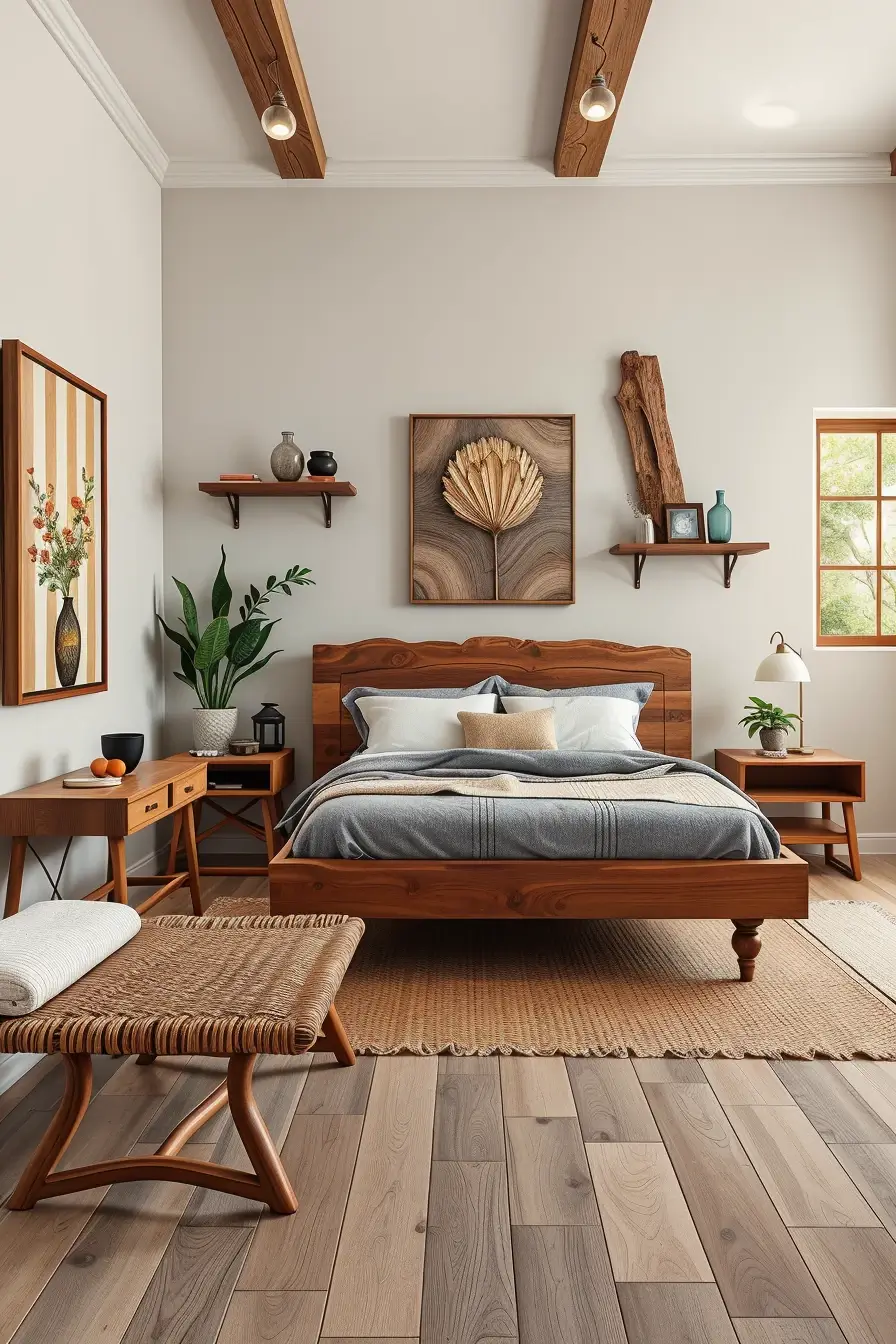
Haven’t you felt calmer after walking into a room with trees or immediately refreshed after growing a new plant at home? Thanks to biophilic design, we can draw deeper inspiration from nature by creating rooms very intentionally. In this article, I’ll walk you through different ways to design your bedroom using biophilic concepts, not just with plants. We’ll take a look at natural light, organic solutions, earthy tones and how the surroundings and room plan can make you feel good.
If you want a bedroom that’s refreshed or just needs a little nature, these ideas will ensure your new space is chic and relaxing.
The Core Principles Of Biophilic Design
I always make sure to focus on the core ideas of biophilic design: including natural aspects, many ways to stimulate your senses and a link to the outdoors. You should pick surfaces that remind you of the outdoors, as well as think about air quality, how much light there is and how the space moves from one area to another. Besides looking natural, a true biophilic room should also bring nature to your senses.
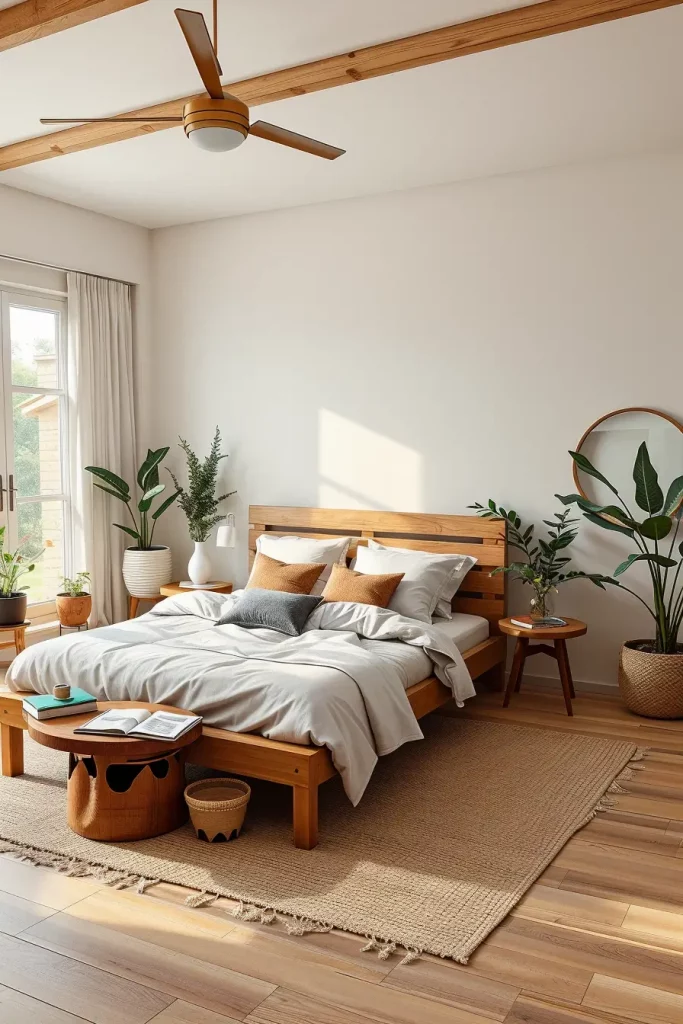
If you want to use the theory in your bedroom, I suggest installing wooden headboards, using linen sheets and hanging light-filtering curtains that let some light shine in. Stick to rounded shapes in your furniture and use woven patterns or pebble-style items on the walls to feel closer to nature.

I have found that the textiles we choose can shape our sleep, mood and stress. These findings match Amanda Sturgeon’s point in Creating Biophilic Buildings, where she highlights that genuine biophilic spaces stimulate all the senses and boost both our feelings and wellness.
It would be useful if this section included pictures of certain biophilic furniture such as a bed frame made from wood salvaged from old buildings.
Why Choose A Biophilic Bedroom?
I am asked many times why biophilic design is especially important in a bedroom. The reason is easy: here is where you take a break and get a fresh start. Taking biophilic design into your bedroom shows you truly care about your health and harmony. Studies have found that areas filled with natural features boost thinking, lower anxiety and help people sleep better.
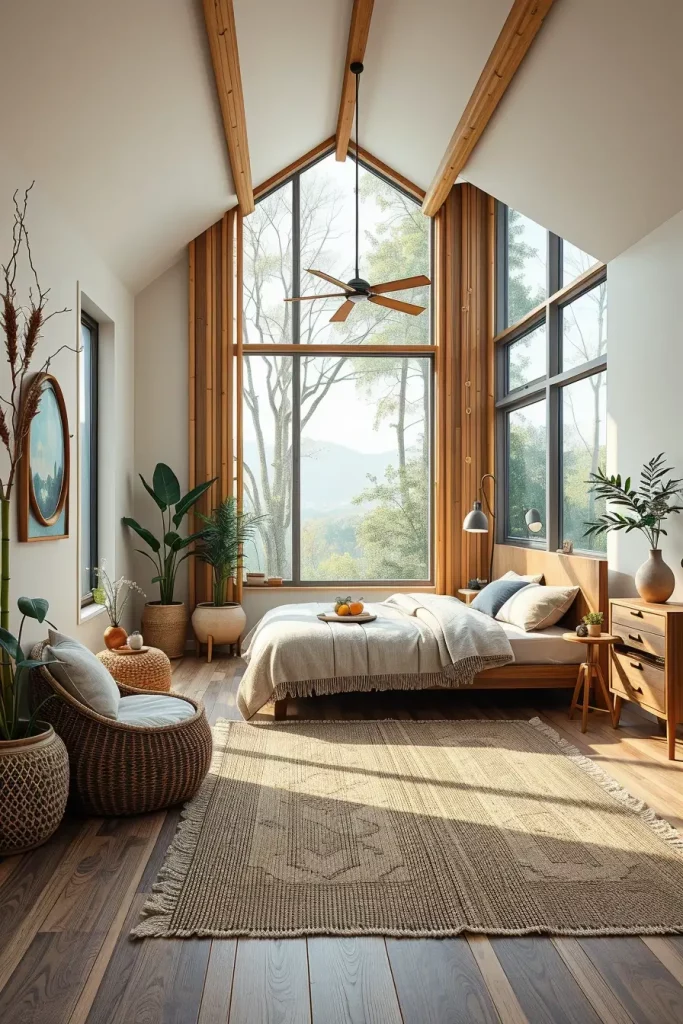
I design my biophilic bedrooms using big windows, natural bedding and bamboo or eucalyptus wood. Dull colors inspired by stone and sand help your body keep a healthy rhythm. Layered lights copy the soft luminance of the sun. A jute rug is a simple extra that gives a touch of natural comfort.
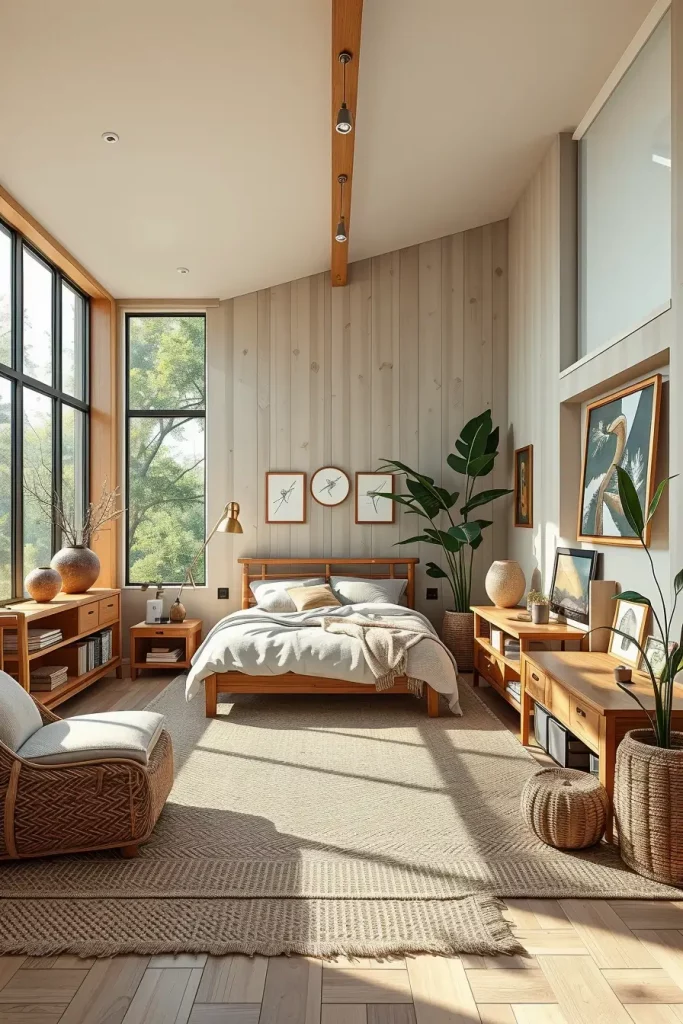
It is my experience that nature, expressed through color or figure, helps me feel steady and more relaxed at home. After using a biophilic design, many of my clients feel that their stress goes down measurably.
Documenting the most recent science about how biophilic design helps to improve health in sleeping areas would be useful. It may be a good idea to include a sidebar or footnote for this section.
Incorporating Natural Light Into Your Bedroom
Natural light is one of the strongest influences biophilic design offers. Maximizing my views is always important to me which is why I alter the floor plan and options for window dressing. When you’re sleeping in a bright room, light can improve your mood and your ability to sleep well.
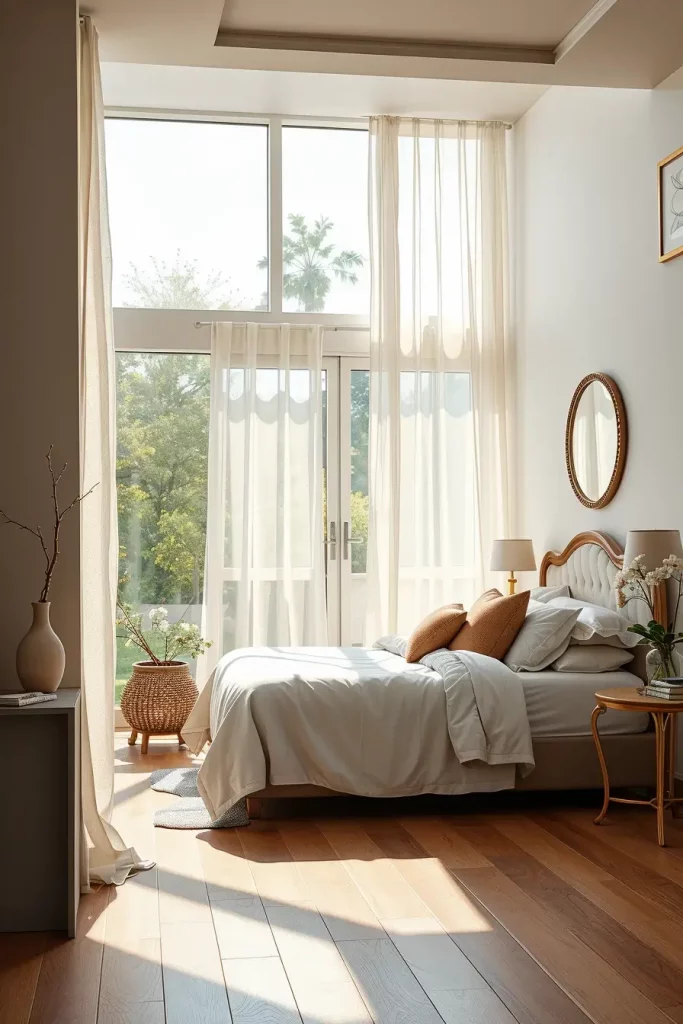
I use sheer linen curtains to spread the natural daylight softly into the living room. When you place mirrors across from windows, you help sunlight reach a greater area inside. If you worry about privacy, top-down shades are safe and reasonable. They let brightness in while still blocking your privacy.

I changed the position of the bed in my room so I would wake when the sun rose to the east. After this, I noticed a big improvement in how I feel when I wake up. Architectural Digest recommends using light shades for the paint and keeping your window treatments to a minimum to emphasize the space as well.
You could also add ideas for interior designers who encounter rooms with little sunlight such as using mirrors or installing skylights.
Maximizing Outdoor Views Through Windows
What may be overlooked in biophilic bedrooms is how important a great window view can be. Having a garden around your home is not necessary; you can still design your windows to add a feeling of openness and calmness inside your house.
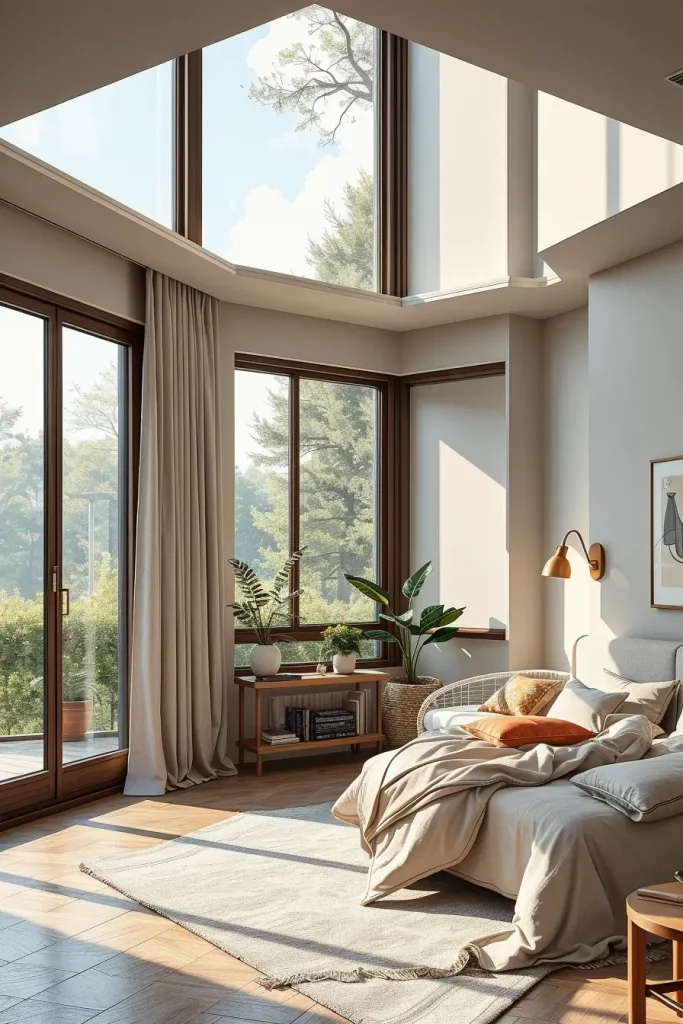
During design, I make sure the bed is opposite or lined up with the biggest window. This way, the view feels they are a part of the environment inside the room. Glazing that covers the floors to the ceiling is the best choice, if practical. For windows that are not very big, I either get light drapes or go without them, so views are not obstructed.

Living in two very different settings, I realized that what’s most important is the emotion a view creates. Even glancing out to a tree or bit of sky is useful for your mind. It has been found by scientists that being able to see green spaces can lower your heart rate and help you stay focused.
I’d recommend covering this section with tips for cities, for example, using flowers in window boxes or adding privacy screens with types of vines to imitate a natural scene.
Using Indoor Plants To Refresh The Space
Lots of biophilic bedroom transformations center on indoor plants since they freshen the air, control humidity and create a bright green contrast. I prefer growing pothos, monstera and snake plants, since they do well in dim areas and don’t need much attention.
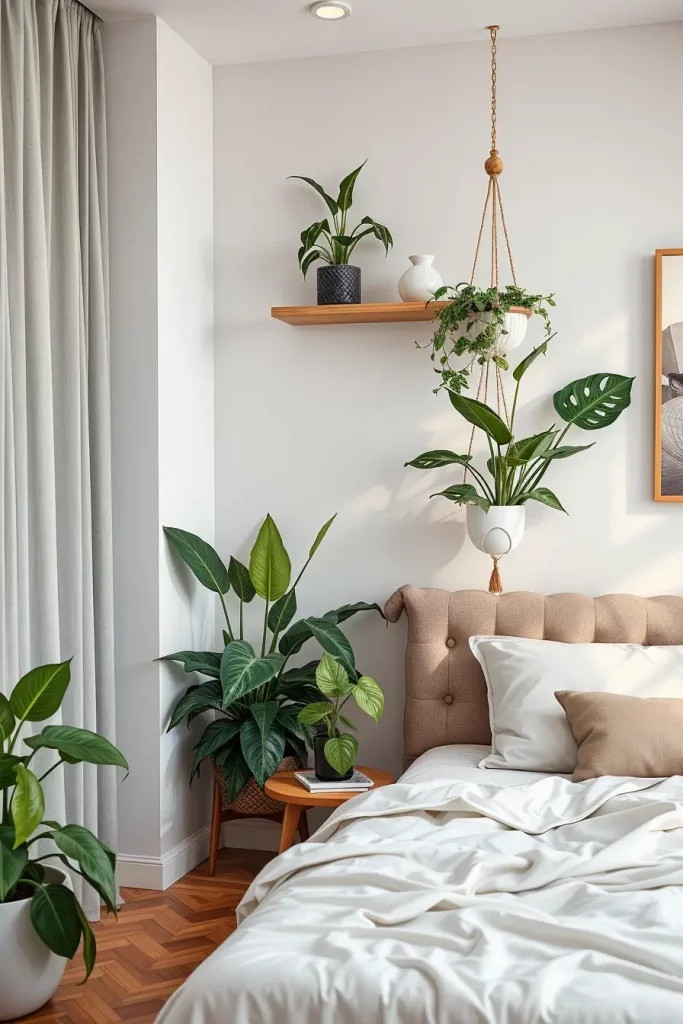
A lot of the time, I choose to put large plants in corners or hang them near windows. Smaller trailing plants are lovely when their vines spill over from shelves around the bed or home. One tree such as a Fiddle Leaf Fig, has the power to be an organic sculpture in a space.
I often change the seasonal plants in my apartment to help everything feel vibrant and new. Better Homes & Gardens recommends arranging different plants together, in odd numbers, to make your display nicer to look at and I’ve had success with this trick.
To add more depth to this section, consider a brief list of plant pairings (e.g., snake plant + ZZ plant) that complement each other in care and form.
Creating A Living Green Wall In The Bedroom
The elegance of a green wall transforms an empty space in your room into its main feature, filling your biophilic design with lush green. These vertical gardens are not just eye-catching—they’re also functional, improving air quality and acoustics. They’re the first thing I suggest to homeowners aiming for a big but soothing effect.

It’s possible to build a modular planter system complete with irrigation or choose easy-to-care for varieties like ferns, ivy or philodendrons in pocket-type planters. It’s best to hang them behind the headboard or on the opposite side of the bed, so they’re easy to enjoy.

In my experience, seeing lots of greenery in the morning immediately improves my state of mind. I found motivation from designers like Clodagh, who regularly adds green walls to spa-inspired bedrooms to help people relax.
A few ideas for DIY refreshed moss panels can be valuable here for those who simply want less effort.
Natural Materials For Furniture And Finishes
How you use and combine materials is as important in biophilic bedroom design as the room’s organization. I use solid wood, jute, bamboo, rattan, wool and stone where possible. They provide the room with visual comfort and richness that artificial textiles don’t have.
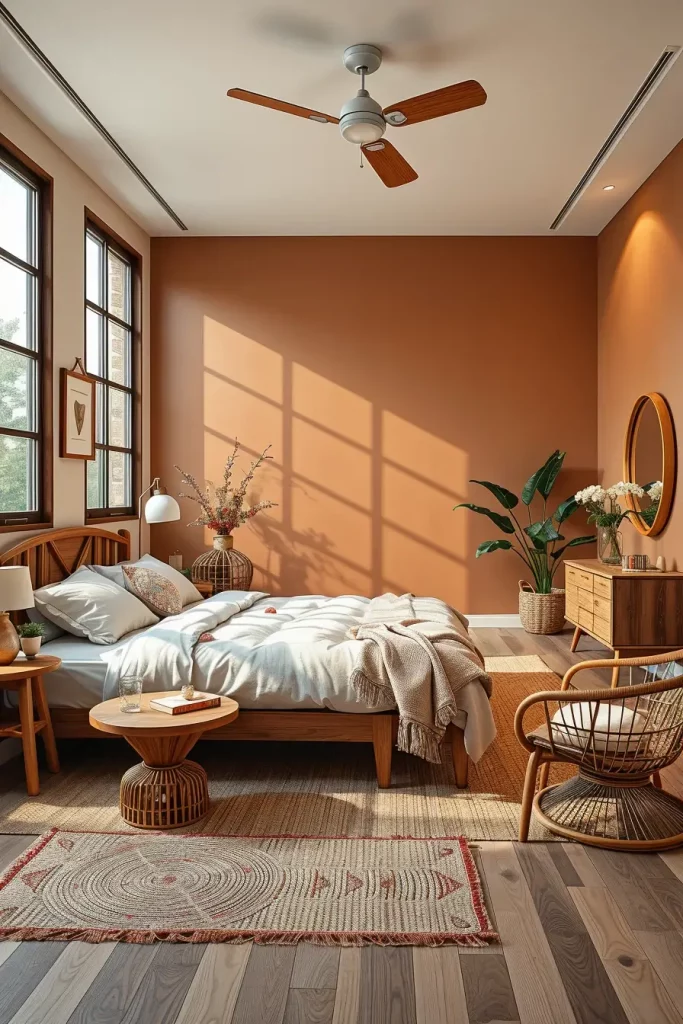
In furniture, I focus on choosing natural wood beds, rattan side tables and sofas covered in linen. Lime-washed walls and clay-based paints are top choices for me because they create a relaxed and soft kind of glow. Natural materials slowly become more beautiful as they grow older.
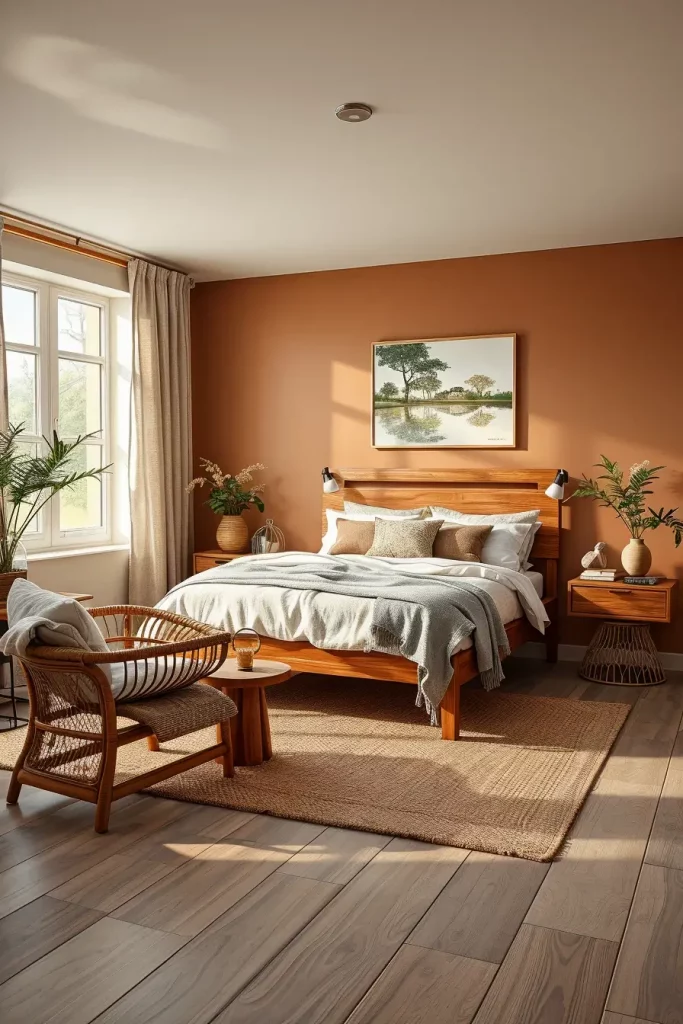
Come across pieces that are both warm in character and sustainable if you purchase locally made furniture. To be most environmentally responsible, Elle Decor recommends buying FSC-certified wood and untreated textiles which is something I always advise clients to do.
Remember, using wood rescued from old buildings adds history, plus suggesting local craft fairs or businesses that focus on nature can help you learn more about using eco-friendly products.
Earthy Color Palettes For Calming Vibes
For me, the mood of a biophilic bedroom is set primarily by the colors chosen. I like using sand, forest green, terracotta and soft clay colors which represent the beauty of the natural world. Looking at these colors soothes your mind and helps reduce eye strain. A space designed for biophilia shouldn’t look sterile or cold; it should feel calming, like a place to retreat.

When finishing a nursery, I tend to paint the walls with warm pigments or apply clay-based designs and coordinate the bedding in soft greens or beige shades. There is instant appeal to cushions in these warm shades as they accent your space subtly. A wall behind the bed painted in terracotta can quietly and artistically draw attention.
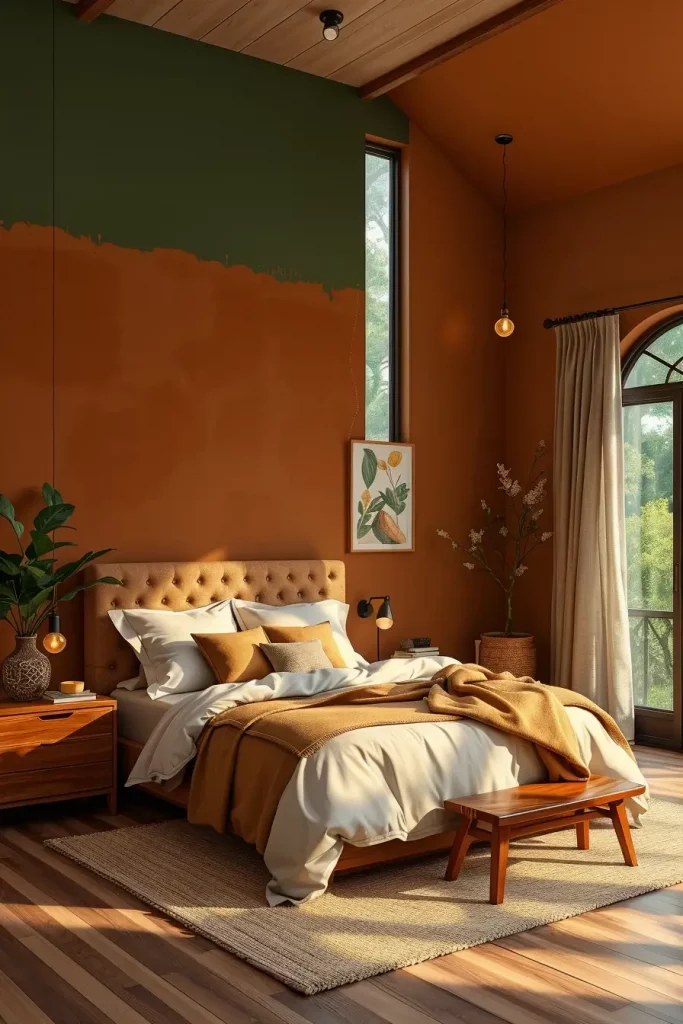
Clients tell me they enjoy better sleep when their rooms have warm earth tones. Veranda Magazine says that colors like those from the desert or forest “banish psychological fatigue that comes from staring at many stimulating things.” It’s for this reason that I always make sure to use a good color scheme when designing a biophilic bedroom.
You can add suggestions for interior design by mixing earthy colors with textures you find in nature such as green walls with rattan lighting or linen curtains.
Wood Accents For Warmth And Texture
Bringing in natural wood is essential for any biophilic bedroom. Their comfort to touch and steady look are two things synthetic products can’t reproduce. Depending on the level of natural light in a room, I tend to use oak, ash or walnut, since these fall into the light to medium wood spectrum.
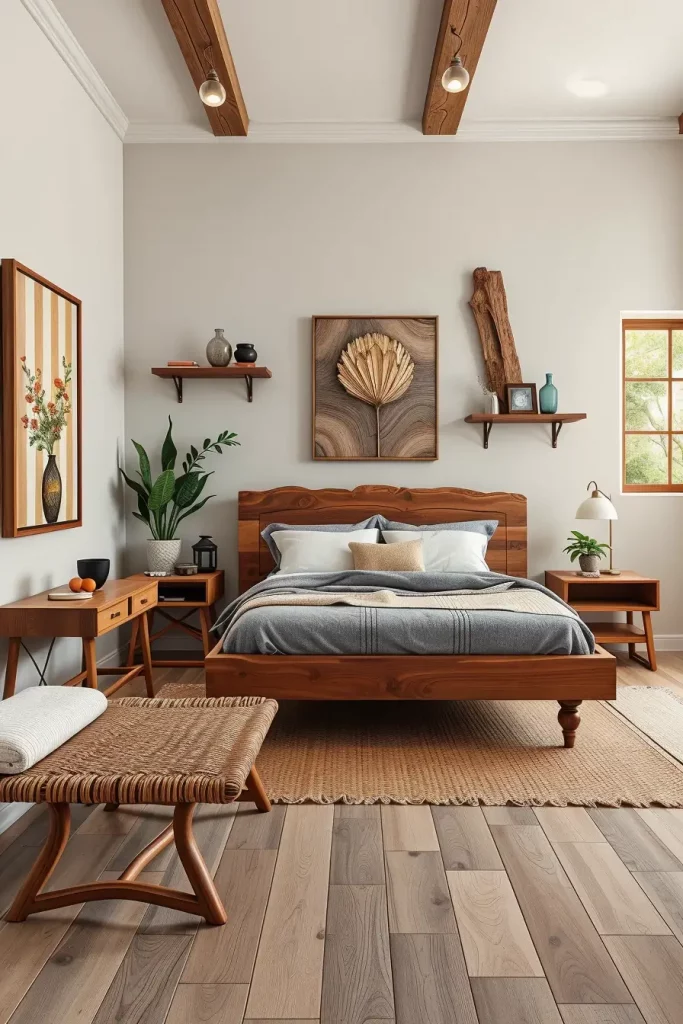
A few of the applications I like best are wood slatted headboards, exposed ceiling beams and wooden floating shelves. Adding a wooden bench at the end of the bed helps with room design and also adds to its use. I use artwork made from driftwood or old wood to give my designs interest and stories to share.
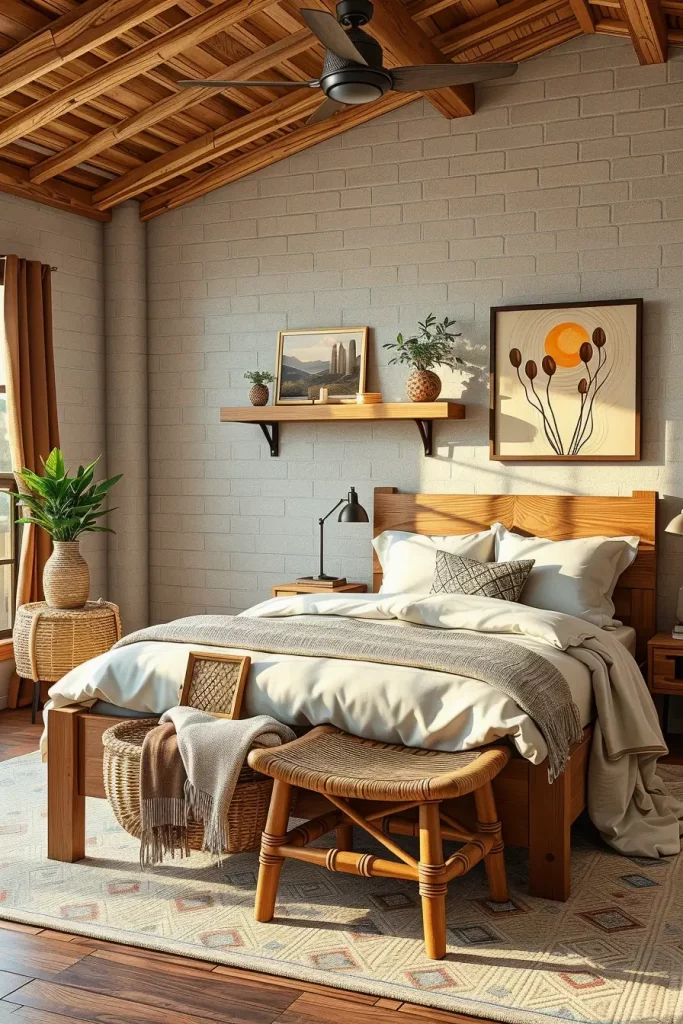
Personally, adding a wood feature or two to a room can make it feel much more soothing. This month’s Domino Magazine highlighted a home where using lots of wood made the space feel cozy and protected and I can certainly agree. All is needed is to embrace balance and accept how unique nature is.
One important thing that’s not mentioned is the difference between wood that’s been treated and wood that hasn’t. You should try untreated or faintly finished pieces when you want a simple or natural look for your nightstand or any decorative panels.
Organic Shapes In Bedroom Layouts
You won’t discover much straightness in nature, so I opt for slightly curved and irregular forms in my biophilic bedroom designs. For this reason, go with curved pieces, select rounded rugs and arrange your decor in unusual ways. Designing a connected, comfortable space that resembles a grove or cave instead of a grid is the main goal.
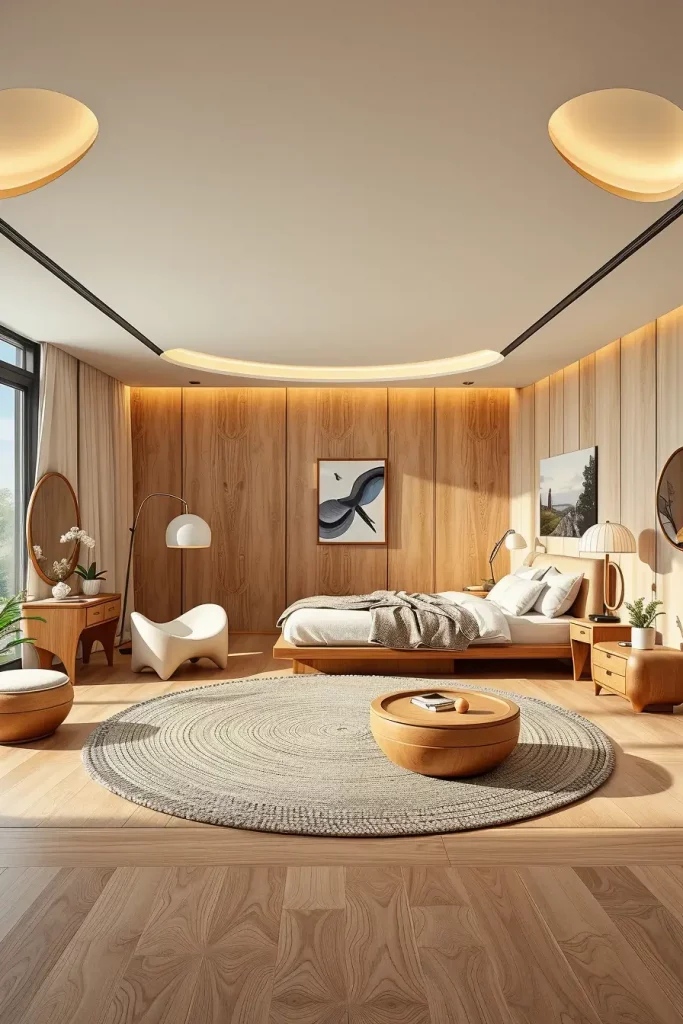
Most of the time, I buy beds with rounded corners, oval tables and lamps with curved or rounded shades. Besides, curved seating, round mirrors and curving wall shelves help make the space seem more natural. Having art showing abstract parts of nature also helps spread the natural theme.

It seems that, whenever clients step into these naturally shaped rooms, they quickly feel at ease. This follows the ideas of designer Ilse Crawford, who thinks “softness, curves and how items feel can provide human comfort.” In my projects, I’ve noticed this plays a big role too.
For small bedrooms, it would be good to highlight organic shelving units made with modules or built-in which add both style and useful storage space.
Bringing In Fresh Air With Natural Ventilation
A biophilic bedroom aims to feel good, but people often forget about air quality. Making sure natural air circulation is possible in a room is very important to me, as I want the room to function much like a living thing. A beautiful space can quickly turn uncomfortable if there’s no breeze flowing inside.
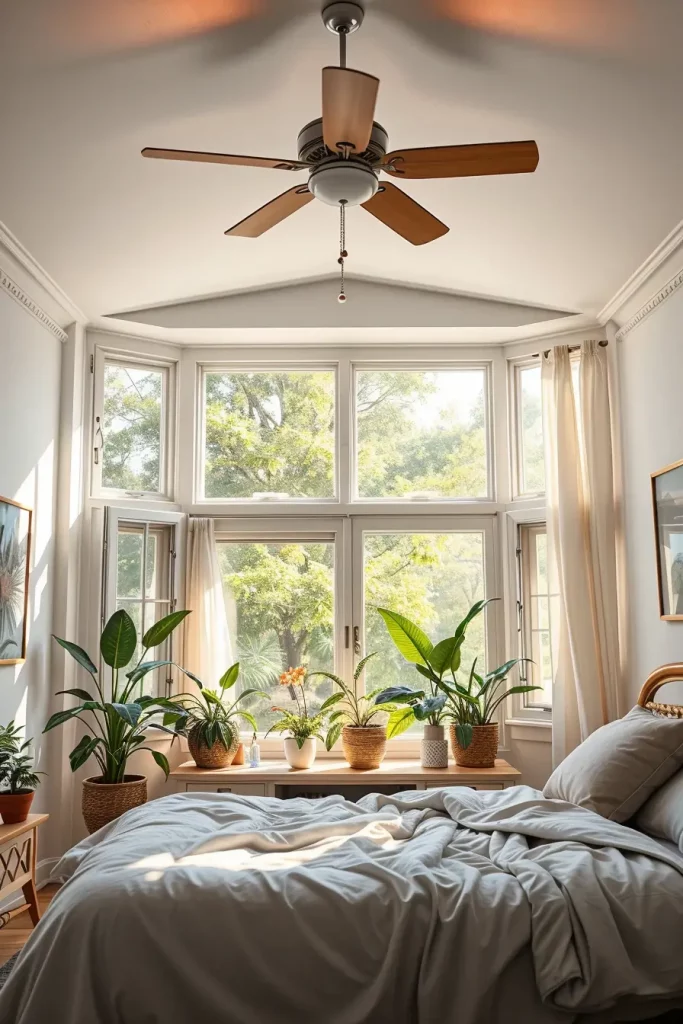
Designing two openable windows across from one another on opposite walls is my choice whenever I get the opportunity. Wooden-bladed ceiling fans are gentle and operable skylights make it easier to bring fresh air inside in the evening. I tend to suggest using window louvers if you’re looking for both air circulation and privacy.
To me, sleeping is easier when the air is always fresh in the room. A recent Well+Good piece noted that better airflow lowers allergens and improves your cognitive function. This has happened with me and that’s why I always recommend putting it first, especially for clients who might have sleep or allergy problems.
Adding a quick tip advising against using chemical cleaners when airing the home and encouraging people to include peace lilies or spider plants in their window spaces would help both the environment and appearance.
Using Sustainable Textiles And Bedding
A biophilic bedroom should combine sustainability and cozy comfort. I pay more attention to sustainability in our textiles and bedding, as they are closest to your skin. Using natural, harmless materials is a main part of living naturally.
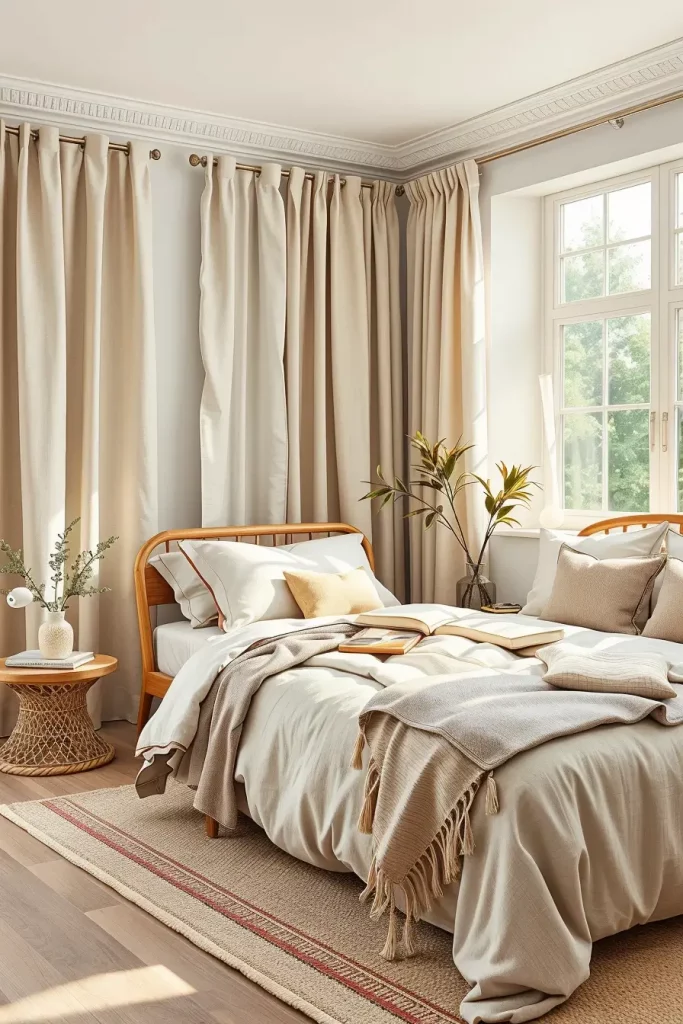
I tend to use organic cotton, bamboo viscose, hemp and flax linen fabrics the most. I prefer to use bedding that is both GOTS-certified and made in gentle, breathable weaves. Throws created from undyed wool or alpaca give both texture and coziness and still meet eco-standards. Ordinarily, curtains should be created using unblended natural fabrics.
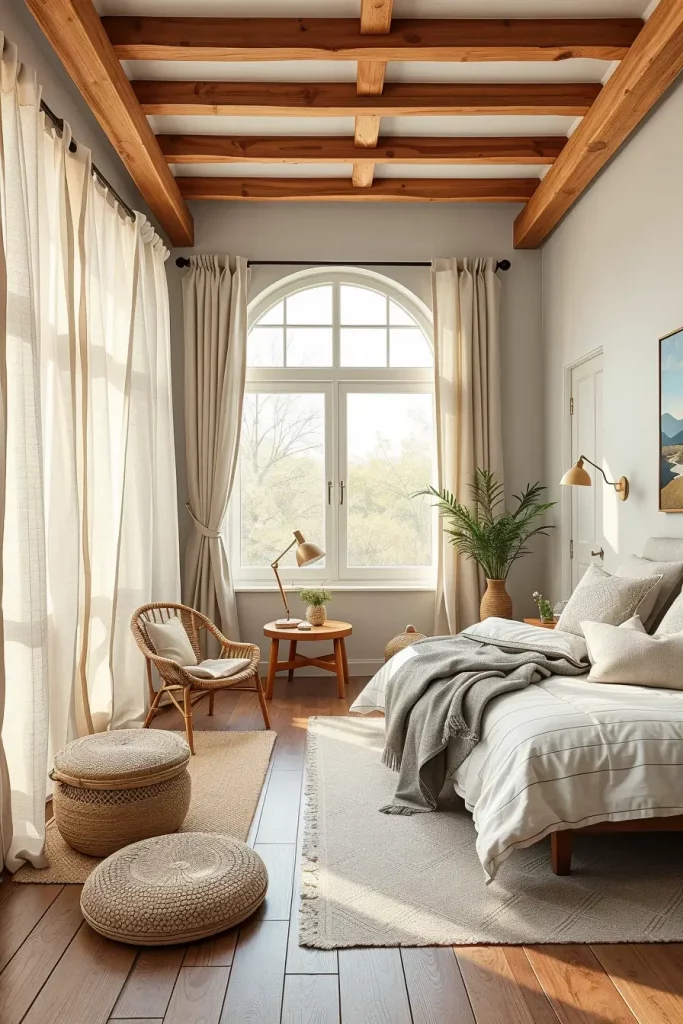
Moving to organic bedding in my home solved most of my bedtime allergy and skin issues. The magazine brought attention to this trend by saying that natural bedding promotes better sleep and a healthier environment which I regularly mention to my clients.
This guide might also need to cover fabric care. Help your audience continue to be sustainable by pointing out that washing clothes in cold water with eco-detergents will keep them from being thrown out too soon.
Natural Stone Elements For Visual Connection
Stone has been used for a very long time and it makes for a good biophilic bedroom detail, helping to link people with nature. Natural stone shows itself most subtly but visually in accessories, wall panels or surfaces.

I like the look of a slate or marble accent wall as the backdrop to a headboard, because it brings interest and balance to the room. Bring interest to your bedroom by including smooth nightstands or bedside lamps with stone supports. Giving your landscape contrast is easy with stone trays, candle holders or flooring with pebbles.
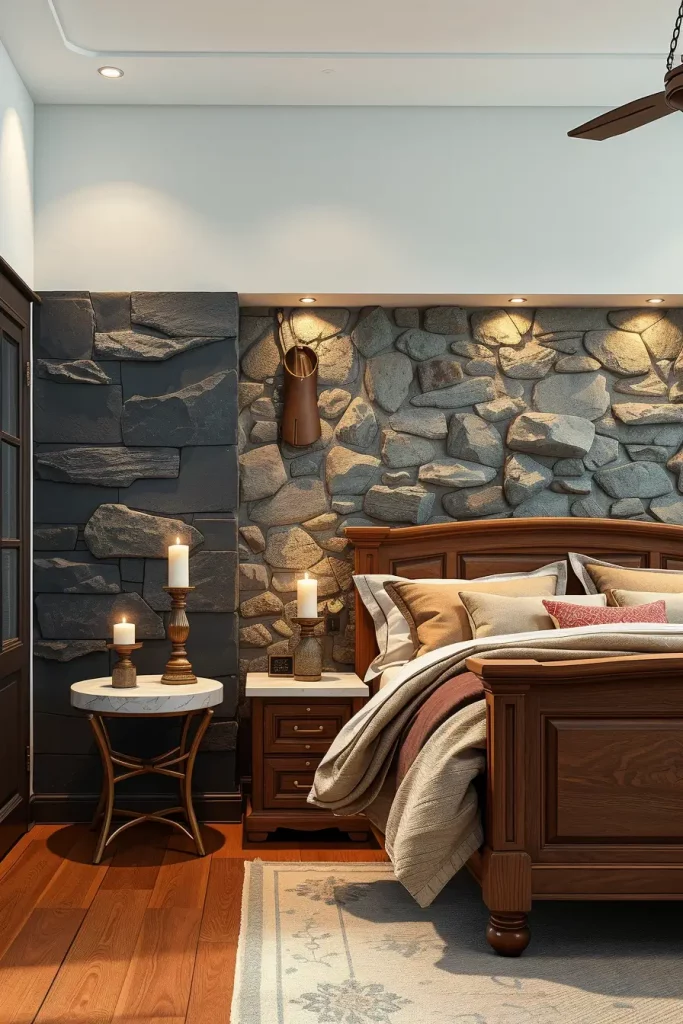
I’ve seen that adding stone to my projects gives a room a lasting feel and helps calm everything else happening with the room’s materials. Dwell magazine once called stone the main element that brings timeless feel to interiors, an idea that’s stayed in my mind.
You may wish to add suggestions on including stone in a cold-weather setting, like putting radiant floor heating or comfortable, warm, wool rugs there.
Aromatherapy With Natural Scents And Essential Oils
Adding natural aromas to your air with aromatherapy makes the bedroom more comfortable and helps you relax. I’ve created rooms for clients where a calming scent is as important as the things they can see. Making an aromatherapy area nearby your reading or bed area offers you many wellness benefits and supports the biophilic style of your room. Group your essential oils in trays or holders made of wood or stone to make your shelves look attractive and useful.
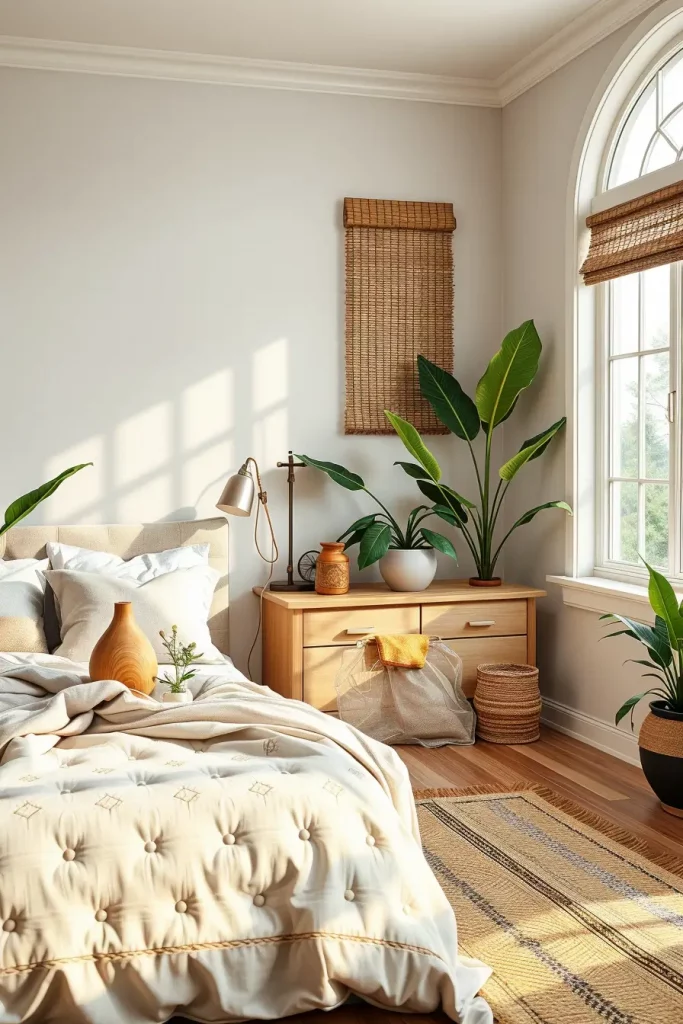
I usually choose diffusers that are ceramic or cut from wood—they blend well with bamboo shades and rattan pendants in the room. The relaxing effects of lavender, cedarwood and eucalyptus essential oils are recognized; I find that using them creates a true natural environment. To improve their results, put them near windows or plants that allow light in.

From a professional standpoint, mixing natural aroma with organic materials makes it easier for me to relax. The National Sleep Foundation reports that smelling lavender and chamomile can improve how soundly you sleep. I wind myself down each evening by leaving a clay diffuser on my bedside.
For a more convenient option, an aromatherapy shelf mounted to the wall or special storage in the nightstand would allow easing aromatherapy use without leaving your bedroom’s design off-kilter.
Water Features For Tranquil Bedroom Atmospheres
Nothing is as peaceful as the soft movement of rushing water. Including a small fountain or water feature on a wall adds a lot of peacefulness to your biophilic room. I often put compact water features in spots near seating or in corners to achieve a balanced feel for the space. The sound of water running softly adds white noise and raises the peacefulness in your room.
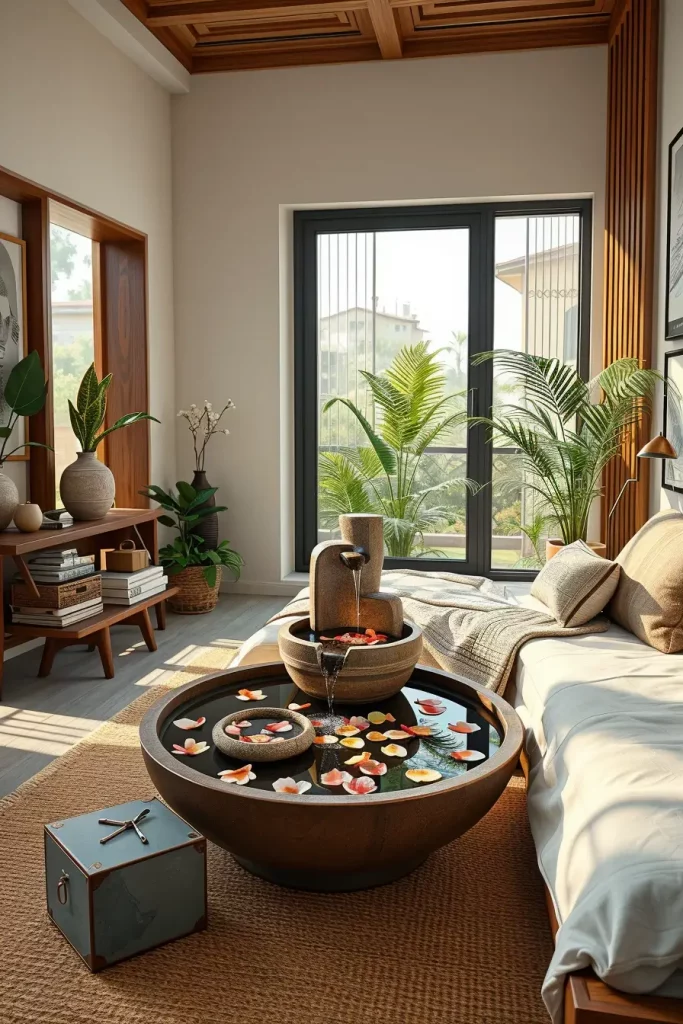
I choose to place ceramic or slate mini fountains near my wooden furniture and neutral bedding. Make a floor-level bowl your central decoration by filling it with river stones and some floating petals. The textures from linen, jute and plants go very well with these pieces.
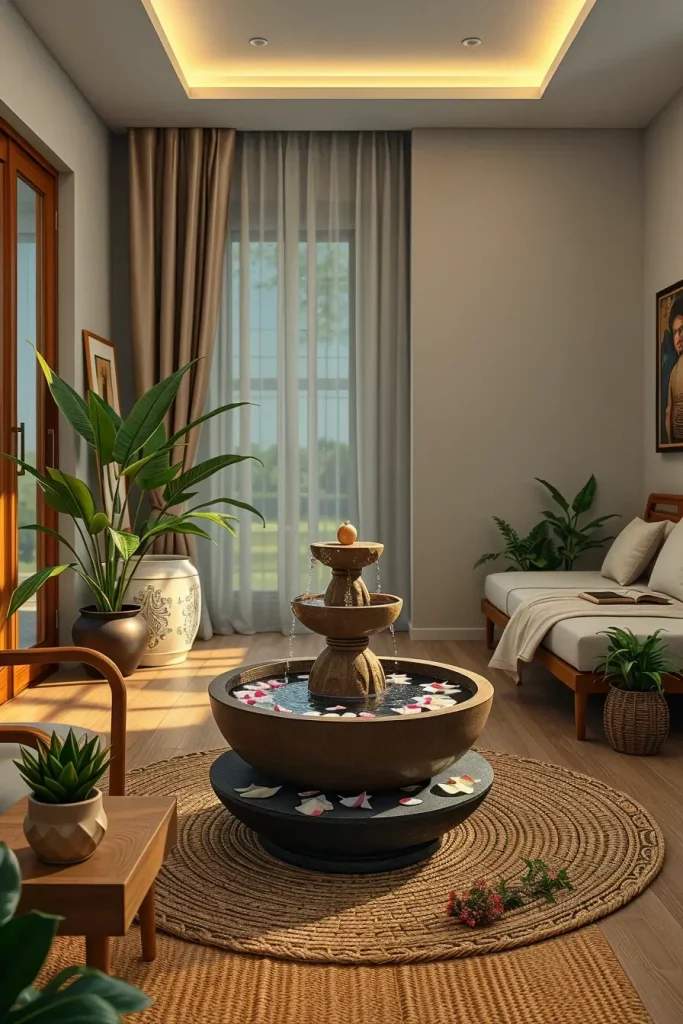
To me, water features often make a big difference to the mood in a room. Some clients notice better sleep by having a small fountain by their bed at night. As Architectural Digest points out, water elements can relax people and bring down their stress and blood pressure.
For the best effect, consider putting LED lights behind a wall fountain and adding diffusers for scent to create a full sensory area.
Lighting Inspired By Natural Rhythms
The lighting in a biophilic bedroom helps set our sleep-wake patterns. I usually adjust the lighting to move with the light throughout the day, installing layers of light with dimmers and warm colors. Let in plenty of natural light with big linen sheers and then attach adjustable LED bulbs to stay luminous at any time, setting the mood as it would with sunrise and sunset.
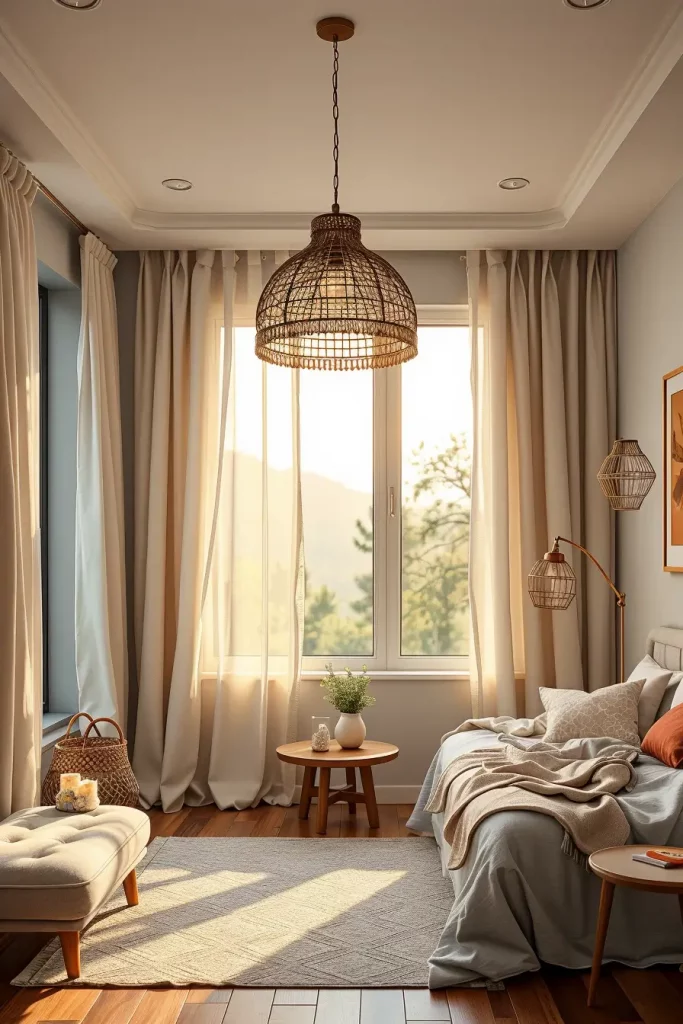
Joonee’s organic shape wall sconces with wooden bases have a natural appeal. Himalayan salt lamps are also part of my decor which gives the room a soft, pink glowing glow. Sculptural, with a natural bamboo or rattan shade, this pendant light becomes the highlight of your room.

Since I got a dawn-simulating lamp, the way I wake up is much easier on me. According to Sleep Foundation findings, being exposed to light can affect melatonin, so using these features in your design follows circadian health guidelines.
Lights that turn on or off at sunrise and sunset or curtains that travel on a timer when it gets dark, are ways to upgrade the design even more.
Nature-Inspired Art And Wall Murals
Putting up art can change a bedroom right away and in biophilic settings, prints of nature connect the room to the outdoors. Using a large decorative botanical wallpaper on one wall makes me feel as if I’m in a green space. Minimal homes often use just one interesting landscape canvas to set the scene.
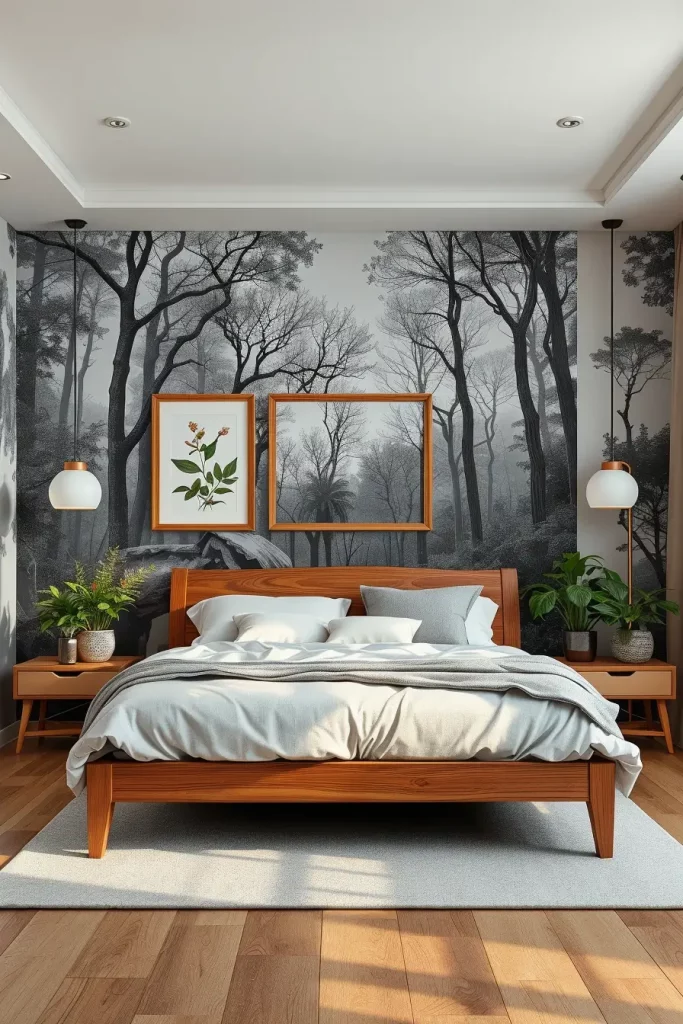
Wooden frames, paintings on linen or stone-decorated sculptures make the room’s design stand out. I usually go for forest photos in black and white, surround pressed leaves with frames or paint scenery from mountains and water with watercolors.
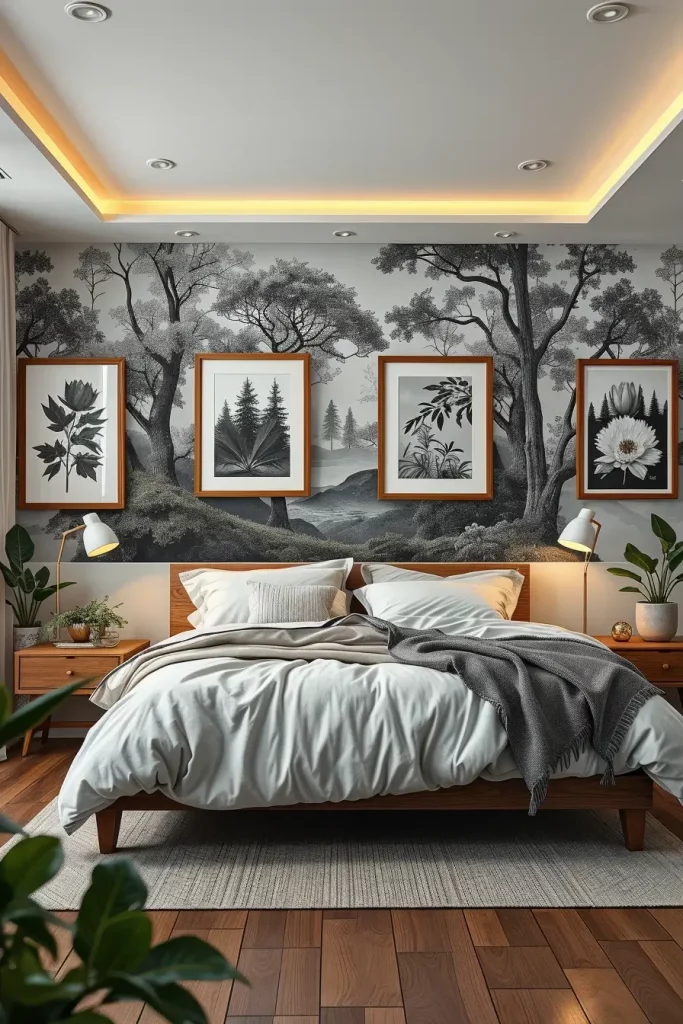
I’ve put murals with forest pictures in different bedrooms and the effects are always very uplifting. Dwell Magazine reports that seeing a photo of nature can lower your stress hormone levels, no matter where you look at it.
Placing decorative walls alongside hanging plants or shelves will beautify and make your home useful.
Textures That Evoke Nature And Tactile Comfort
In a bedroom, texture is very important in biophilic design. I add texture to my designs with wool, cotton, linen, rattan and reclaimed wood. The use of these materials allows visitors to touch them and experience a stable feel.
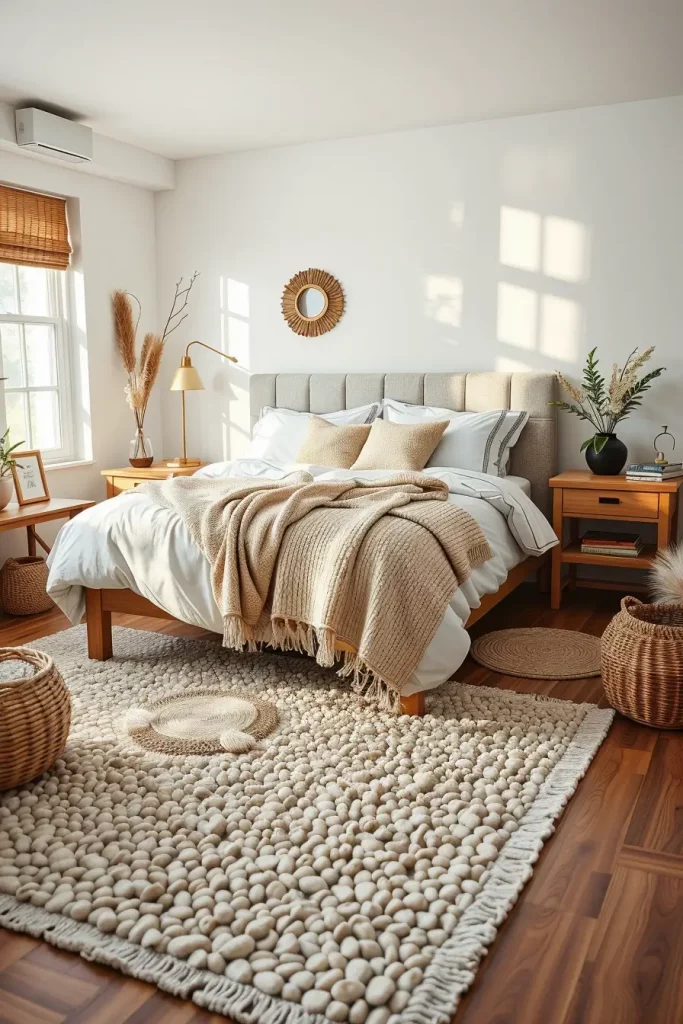
I believe high-quality cotton or hemp sheets with a relaxed, slightly uneven texture are the best for bedding. A large wool knit covering a flat linen duvet provides both a cozy look and feel. You get a natural, earthy feeling from woven baskets, wooden nightstands and rugs with a smooth pebble pattern.
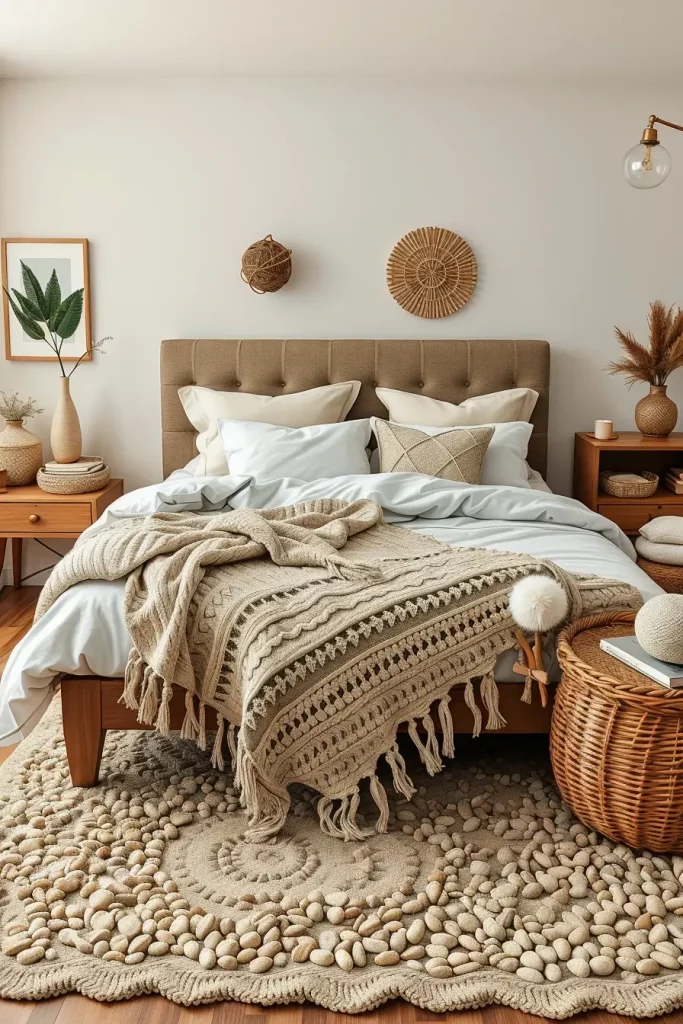
In my own projects, I’ve found that texture makes a huge emotional impact. Changing from synthetic fabrics to linen or wool can quickly make your home more appealing. According to Elle Decor, some designers believe weaving several textures into a room is a simple way to achieve a pleasant biophilic atmosphere.
To deepen this section, I’d suggest incorporating handcrafted pieces—like artisanal throws or ceramics—which introduce character and support sustainable practices.
Designing With Biophilic Patterns And Geometry
In biophilic interiors, the key shapes of nature include fractals, spirals and branches. I find that using these natural patterns in fabrics, paints and seating gives a room great character. Decoration with leaf designs, wave-like headboard art or lattice wood paneling all add rhythm to a bedroom.
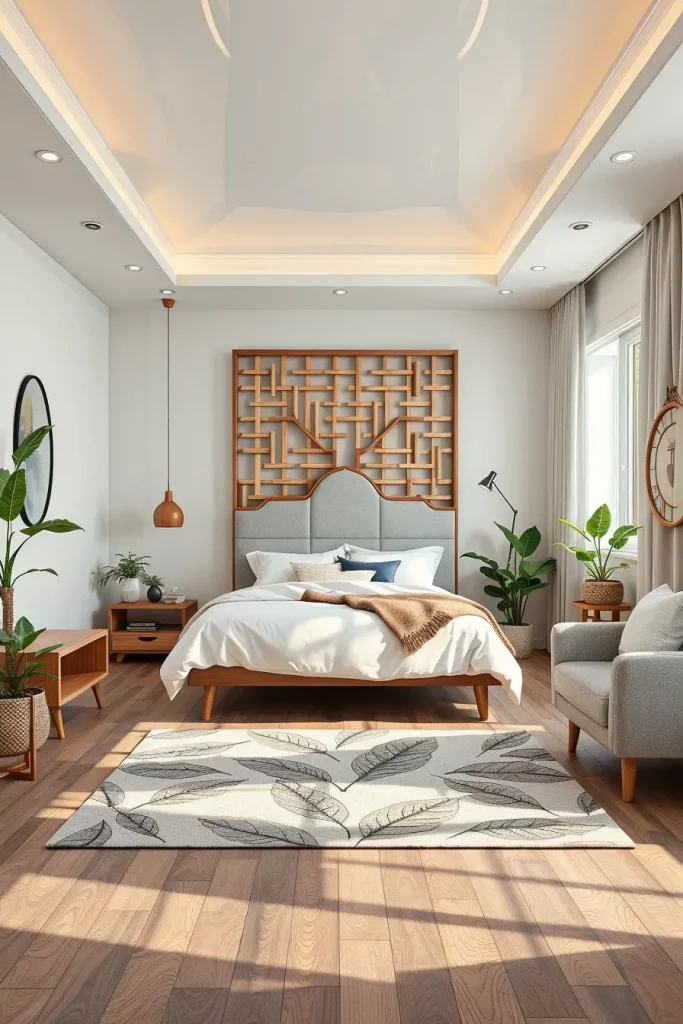
You can add geometric patterns to your ceilings, shelves or walls using laser-cut dividers. They add shape to the room but in a way that is pleasing, perfect for ensuring your bedroom is calm.
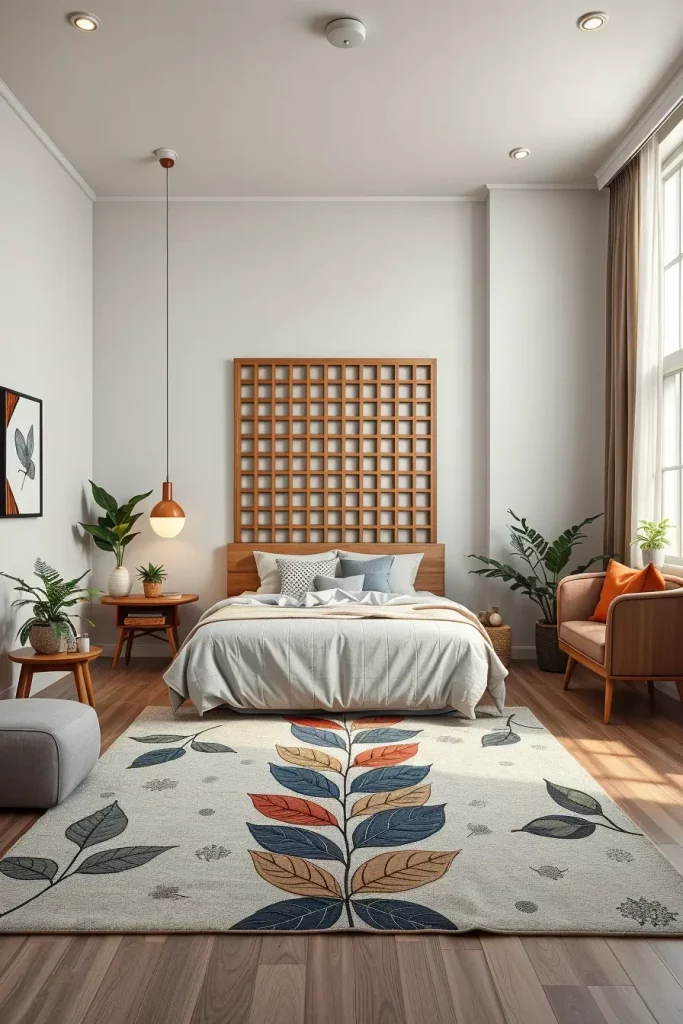
I have applied biophilic geometry to modern designs as well as to older homes. According to Biophilic Design: The Theory, Science and Practice, having fractal patterns in your environment decreases stress and makes vision more comfortable which supports good sleep and recovery.
I’d like to include more examples such as decorative screens or bedding with geometric leaves in the room, unifying the space better.
Open Space Planning To Enhance Flow And Calm
It’s important in biophilic design to encourage movement and visual contact across open spaces. It’s best if rooms don’t include heavy furniture and instead feature open, airy spaces. When you have floating pieces, beds close to the floor and secret storage spaces, a bedroom becomes light and roomy.
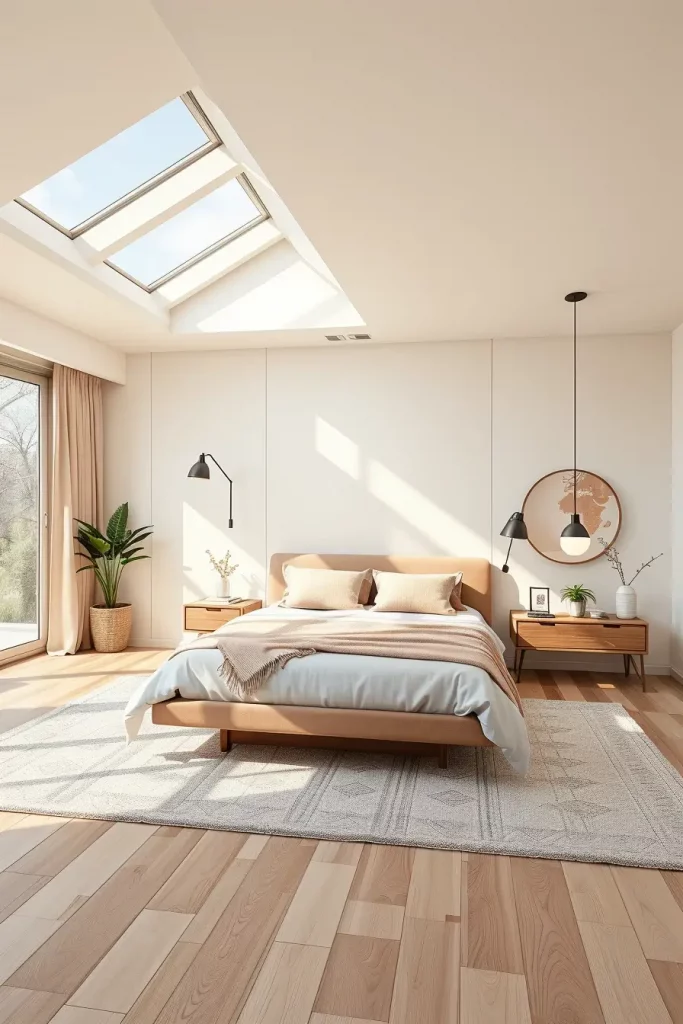
Using Platform beds with open supports and hanging nightstands is the way I maximize the space below them. Using light oak or maple flooring and soft cream walls allows plenty of natural light to shine through the room. There are not many rugs so the stone or wood can stand out.
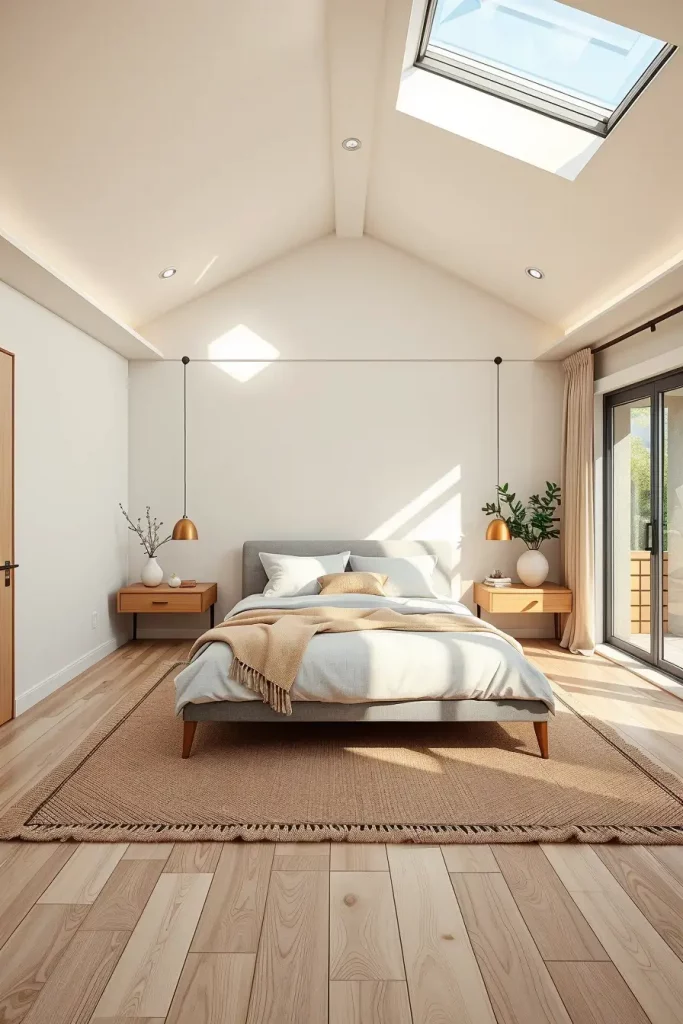
In my experience, clients who have open layouts tend to be less worried and more comfortable. Better Homes & Gardens explains that wider bedrooms can bring about lowered heart rates and greater comfort.
This idea can be widened by using things like exposed beams or skylights to help bring more height and natural light into the space.
Framing Nature As A Focal Point
Adding a central focus of nature in the bedroom is one of my best biophilic strategies. All these natural items help soothe the room and act as a reliable focal point. Every chance I get, I point the bed or reading area towards a garden, balcony or a plant wall to create a link to nature.
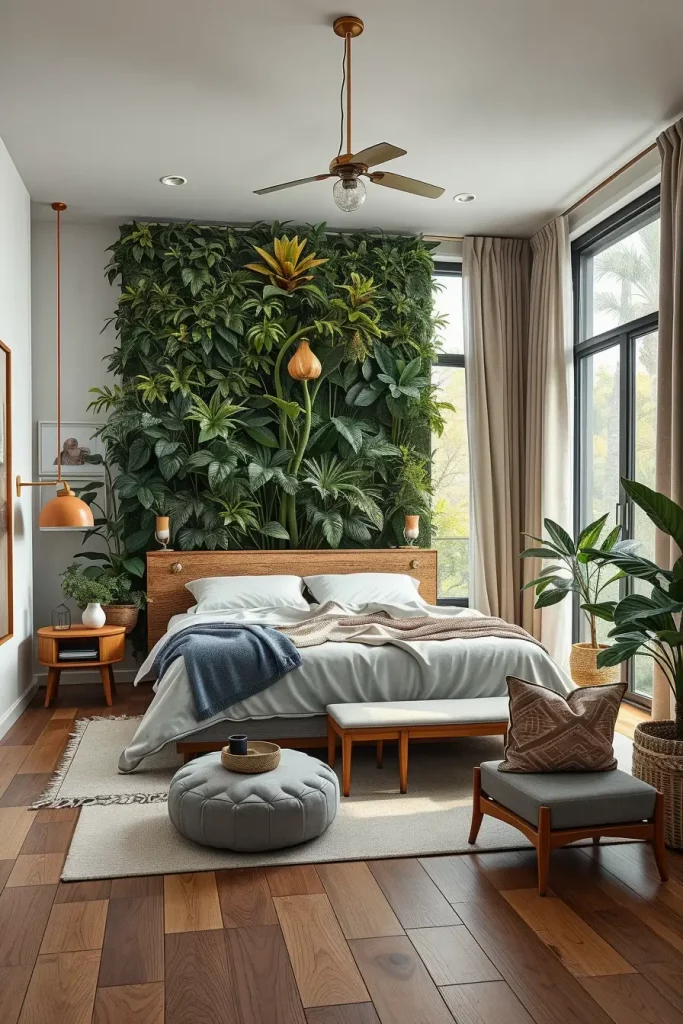
I can go with a large planter with a fiddle-leaf fig or I can add a vertical garden behind the headboard. Cutting-edge bed designs can also be shown off well by using natural wood or a textured wall behind the bed. Filling the walls with curtains from floor to ceiling in cotton or linen will enhance symmetry and direct the eye toward natural details.

The experience for me is that letting nature be the main item in the space helps the room feel calmer as a whole. Veranda Magazine suggests setting furniture around a window with plants so you can enjoy the biophilic effects which is a tip I always like.
Adding adjustable spotlights directly to your natural feature such as a plant wall, would make this section even more appealing in the evening.
Eco-Friendly Paints And Non-Toxic Finishes
Picking ecological paints and toxin-free finishes for your bedroom is very important and easy to forget. I focus on using paints and sealants that do not contain VOCs and are made from plants for better indoor air. The choices are better for the environment and most often result in a matte surface that fits well with a natural style.
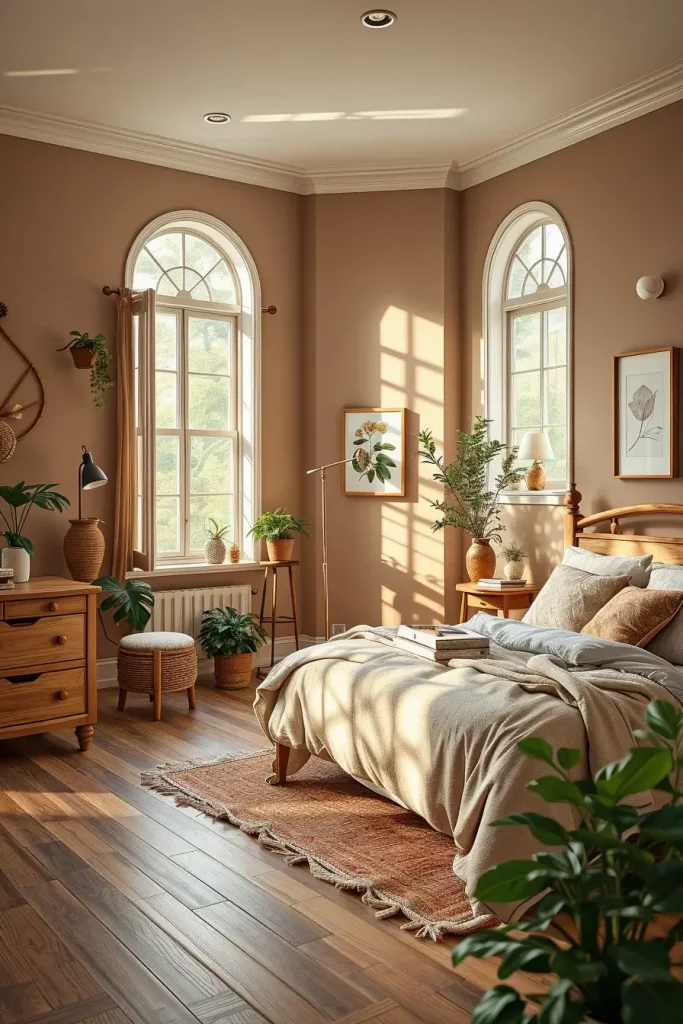
My recommendation is limewash or clay paint in earthy shades of sand, sage and misty gray. The colors resemble nature and help make biophilic-style decor stand out. I also use natural beeswax or linseed oil finishes to treat wood so that the grain stands out and safe chemicals are not used.

A lot of my clients who suffer from allergies or sensitivities find that these products solve their problems quickly. Low-VOC materials, Green Building Advisor argues, help keep the air inside buildings clean and support sustainable design goals.
Additionally, selecting regionally sourced paints or finishes will support local artisans, keep pollution from trucks down and promote better care for the environment.
Minimalist Aesthetic With A Natural Touch
When you use natural colors and textures in a minimal space, you achieve a beautiful biophilic design. I always suggest minimizing the design, cleaning up clutter and keeping it homey by using natural materials. The objective is to reduce distractions while still keeping nature’s inner beauty.

Usually, I have a slim wooden platform bed, simple dressers created from old wood materials and neutral linens for my bed. Extra items are avoided; a thin branch in a soft pot, a soft rug or an old stack of reading material can provide interesting detail, but not be overwhelming. Ivory, olive and driftwood gray colors are seen most throughout the space.
My experience shows that such warmth and minimalism really helps my mind and my clients’ minds stay sharp. Domino Magazine stresses that simple materials in minimal spaces are good for your mental health as they make you brain less loaded.
It is helpful to have hidden storage made from sustainable materials, so the room looks clean while helping the environment at the same time.
Building A Bedroom Retreat With Natural Elements
Giving your bedroom a peaceful atmosphere begins by layering various natural materials. I design each space combining sound, smell, touch and light to encourage people to rest. Treat your bedroom as somewhere to completely relax, not only to sleep.
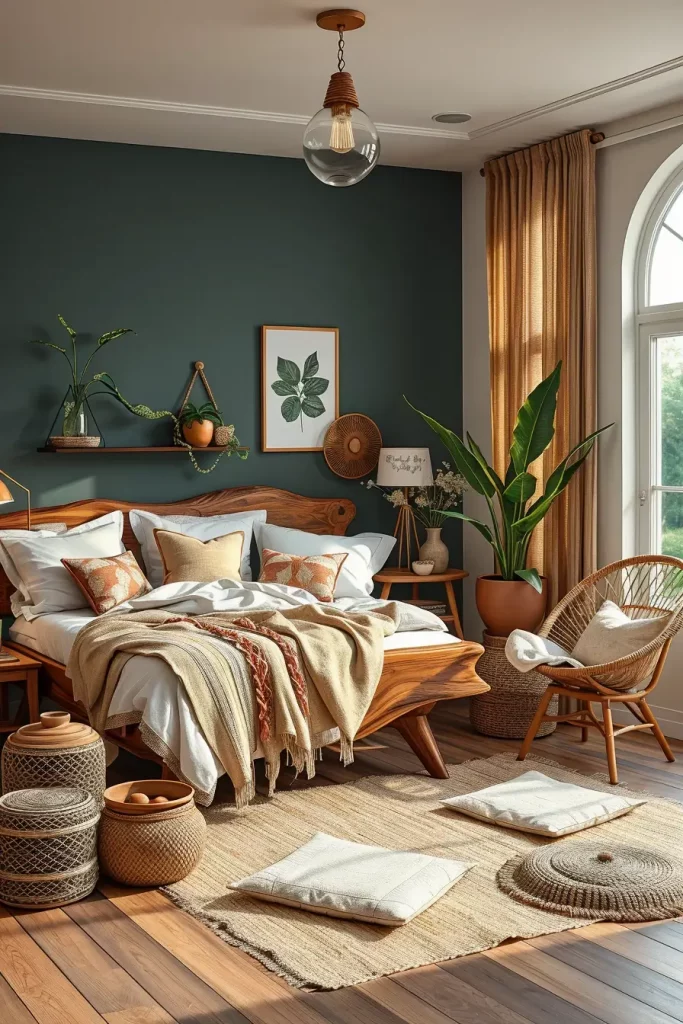
My efforts are centered on basing my projects with solid wood flooring, clay pottery, live edge furniture and organic cotton textiles. Snake plants and pothos are good additions because they help make the air cleaner and support better oxygen supply. Finish off your patio with stone candle holders, handwoven blankets and seating made from wicker.
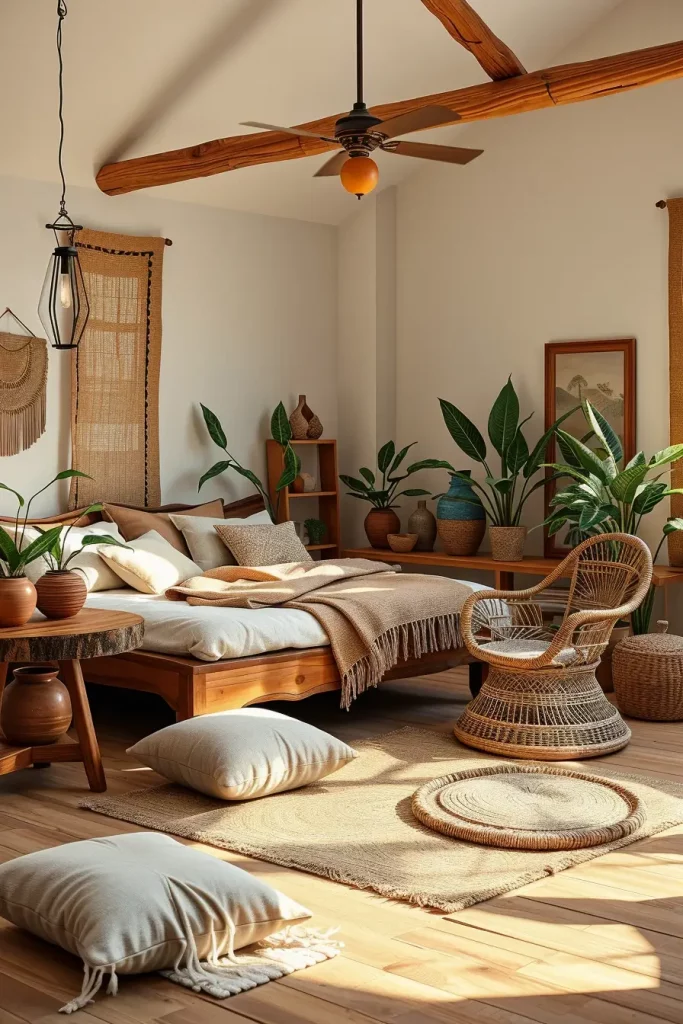
Since I moved in, I’ve always made sure to have a little area with floor cushions, some scents and soft lighting which I use to help me relax. Well+Good advises including soft natural materials close to where you sleep or read to improve your sense of stability.
Hang cork panels or wool curtains to make the retreat area quieter and prettier at the same time.
Seasonal Adaptation With Nature-Inspired Decor
Adapting to nature’s patterns is a main idea in biophilic design—all year, but especially in the bedroom. I love refreshing my clients’ spaces quarterly with decor that reflects shifts in light, color, and texture. Bringing in materials from outside helps a house look more naturally integrated with the world around it.
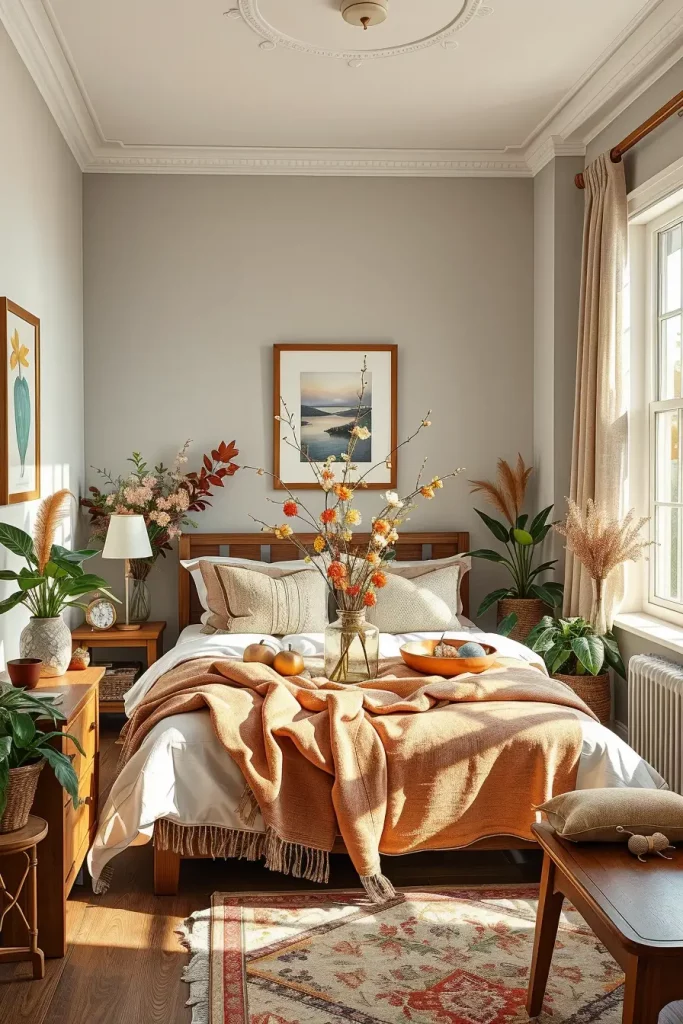
I like to use lightweight throws, hang floral prints on my walls and use pastel bedding in the springtime. During autumn, I move wool blankets onto our beds, place rust-colored accent pillows there and make dried branch centerpieces. Adding flowering bulbs in spring and evergreen sprigs in winter to your planters keeps your space smelling nice and looking attractive.
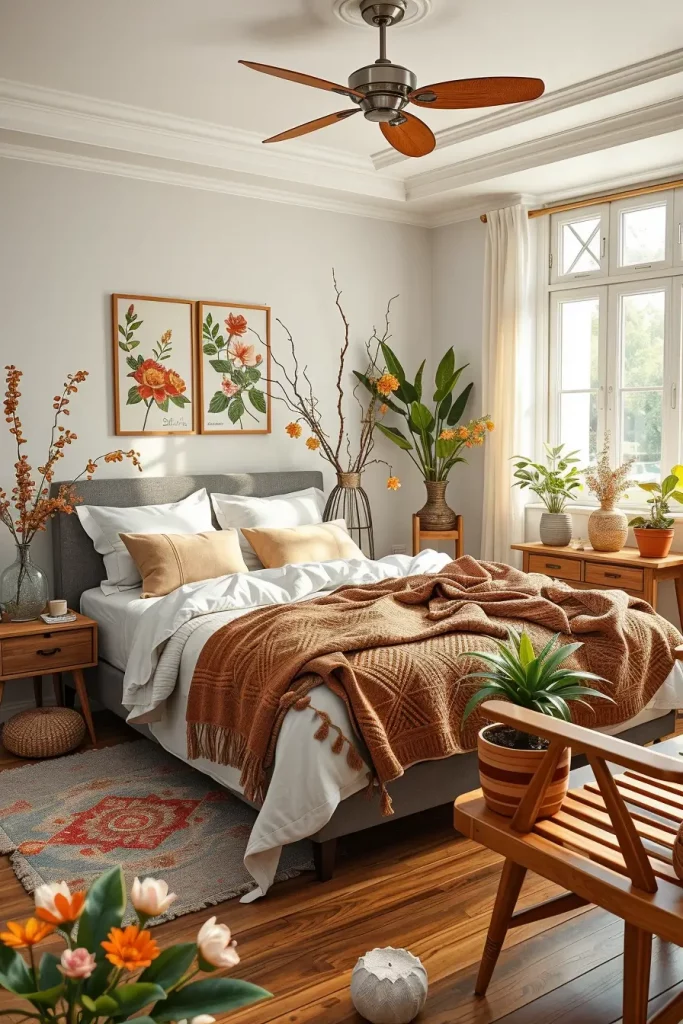
I’ve found this practice not only invigorates the space but also provides a sense of ritual. Emily Henderson, who designs for HGTV, recommends switching out seasonal decor items to keep a space emotionally interesting—an idea I fully agree with.
If you want to enhance this idea, get pillows and curtains designed to let you easily change their appearance, so your updates are easier and more environmentally sound.
Integrating Natural Soundscapes For Sleep
Sound has a big effect on our sense of well-being and with rain, leaf sounds or the waves from the ocean, your bedroom can feel peaceful and safe for sleep. My sleep setup includes quiet or hidden speakers that softly play selected tracks from nature, slowing down the mind and helping people relax.

I install sound devices in wood or hide them behind textile panels so that they do not take away from the overall biophilic atmosphere. I sometimes put in a small water feature that works as noise and also for artwork. Add blackout curtains and ensure your lights are soft to fully rest your senses when you sleep.
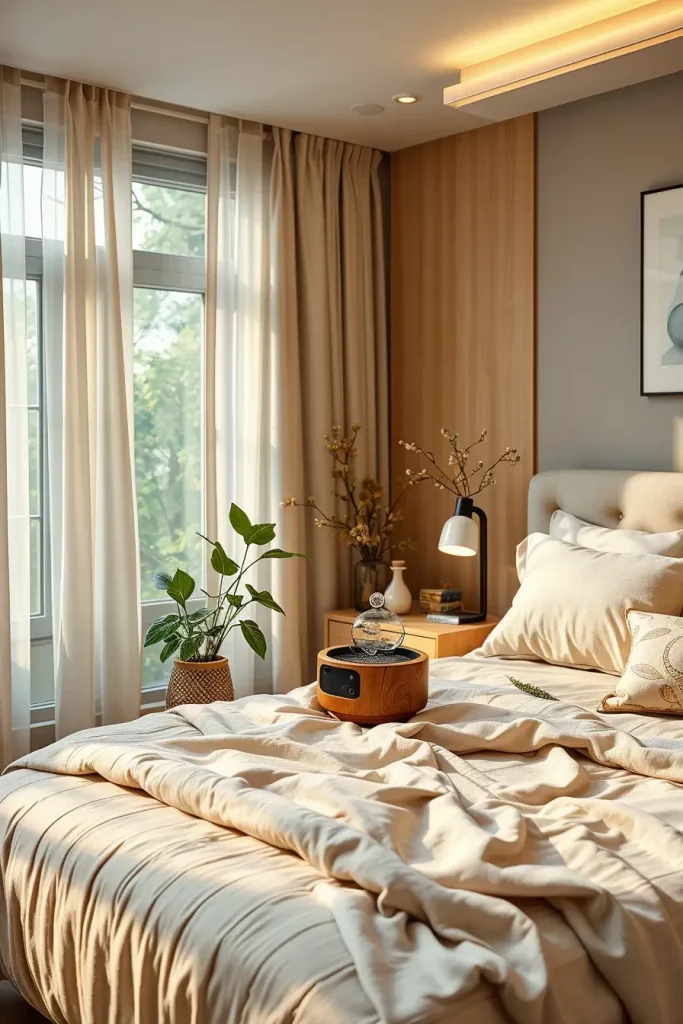
I practice these different techniques in my own bedroom. It’s incredible how different sleeping sounds are when you hear a night full of rain instead of a digital hum. Based on the advice of The Sleep Doctor, simple white noise seems to lower nighttime waking and improve sleep quality.
A possible solution is a sound system that can be programmed to go off at the same time as circadian lighting when it’s bedtime.
Designing Around Circadian Rhythms For Wellness
A key scientific aspect of biophilic design is making the space match our natural sleep and wake cycles. I design the lighting and layout very much following this principle. Designing bedrooms with this approach encourages healthy hormone levels and better sleep.

I prefer to use sunlight by having sheer curtains and correctly positioning mirrors. I install lamps that gradually change from bright white light to warm amber at night which is similar to the light at dusk. I like to suggest using sunrise clocks that help people wake up gently with daylight.

I find that waking to simulated sunrise really helps me feel better and more awake. It is confirmed by experts at Harvard Health that bright light just before sleep or just after getting up, has a major effect on melatonin production which manages our internal clock.
I would further use this concept by including a whole smart-home system that manages lighting, window shades and room temperature according to a person’s sleep cycles.
The Psychological Benefits Of Biophilic Bedrooms
Going green in your bedroom isn’t only about style; it has a strong, positive effect on the way we relate to the outdoors. With large green views and lively plants, as well as using many types of wood, the space is made to help you rest and reset. Adding nature to your most personal room can improve your comfort, emotional state and quality of sleep.

The elements most important for a biophilic room are reclaimed wood headboards, bedding made of soft natural material, houseplants and gentle background lighting. Besides looking good, these decorate make us calm, lower our tension and help us feel refreshed after waking up. I usually recommend having curtains that allow less direct sunlight to help your body’s internal clock relax. The richness and warmth of jute, bamboo and wool can be seen and felt in the design.
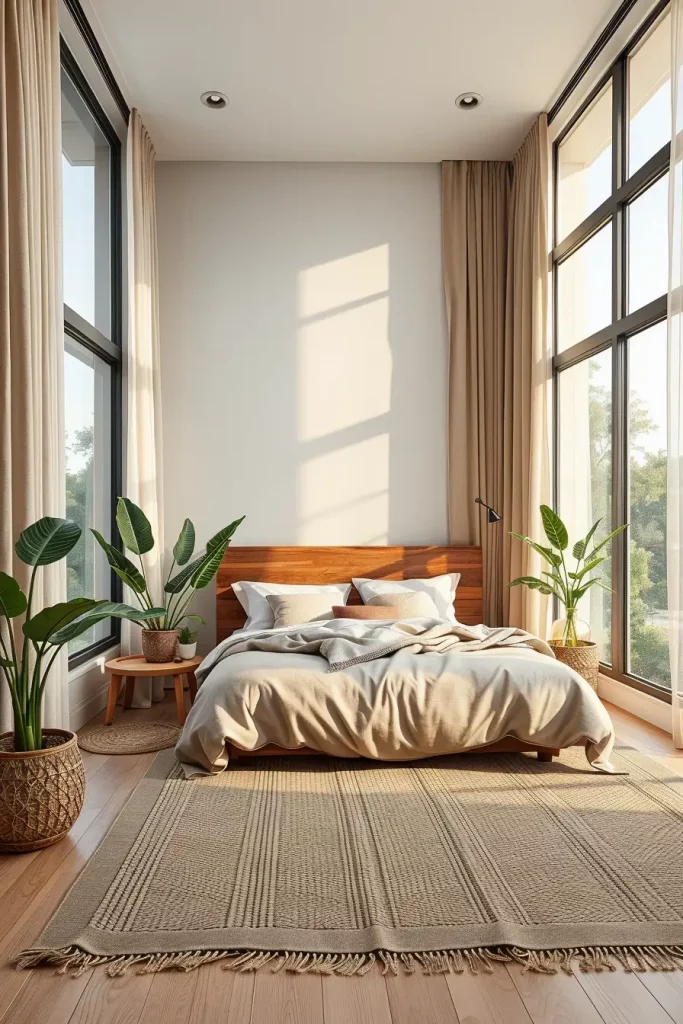
In my experience, looking at a snake plant or a forest print when I wake up helps make me happier. The Environmental Design Research Association claims that simply being around natural materials and images can lead to lower cortisol and better thought processes.
You’ll find that many bedrooms lack a strong focus on wellness design. I would recommend incorporating layered textures, a nature-inspired color palette (like moss green, sand beige, or sky blue), and eliminating unnecessary clutter to help the room feel more emotionally supportive.
Creating A Zen Corner With Natural Influences
A Zen corner in the bedroom helps to combine peaceful feelings with views of nature. A study makes the ideal spot for meditating, reading or taking it easy at the end of the day. Because outdoor access can be limited in some homes, it’s important to make this kind of space for pets. If you place it near a window or next to a skylight, the plant’s calming effect becomes stronger.
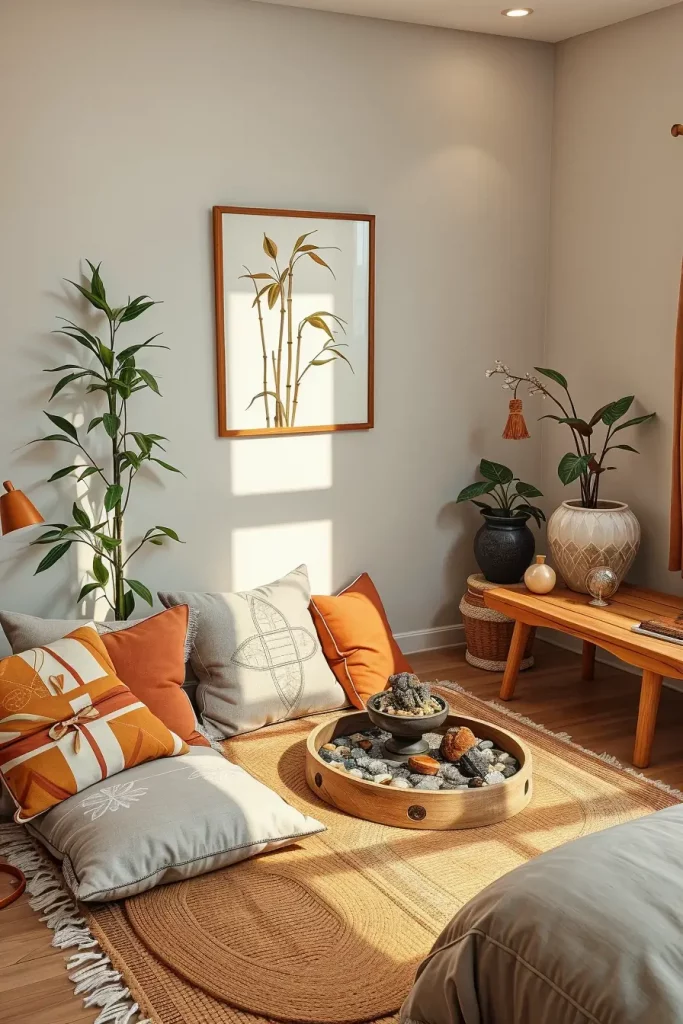
A wooden bench or lots of earth-colored cushions occupy the center point of this corner. Place your fish tank in front of tall leafy plants like fiddle-leaf fig or peace lilies. Incorporate a sculpturally designed water fountain, a tray filled with pebbles and crystals and add woven touches with throws or rugs. To finish the atmosphere, the room uses accent lighting from dimmable wall sconces and some bamboo wall art. All the furniture here was picked for its ability to help a person slow down, reflect on nature and think about mindfulness.
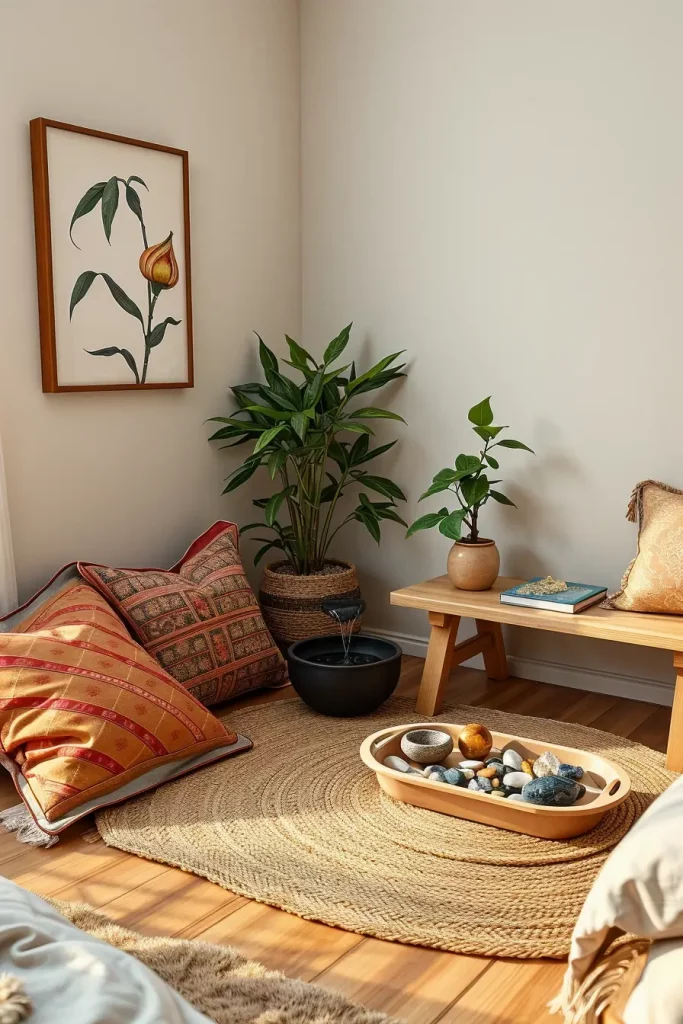
Personally, I see this space as place to avoid overdoing technology. I make my journal entries and practice breathwork in this space. Members of Architectural Digest’s design team note that including alcoves filled with plants can greatly boost a person’s mental and creative health in busy urban areas.
In order to build upon this area, you might want to introduce a portable room divider from rattan and run essential oil diffusers with scents such as cedarwood or eucalyptus.
Maintaining A Biophilic Space: Tips And Tricks
As soon as you make your bedroom biophilic, you need to ensure it stays lively. The needs of your plants, the amount of light and the materials request attention and change from season to season. I notice that when people use simple upkeep methods, they’re more likely to keep their space in good shape.
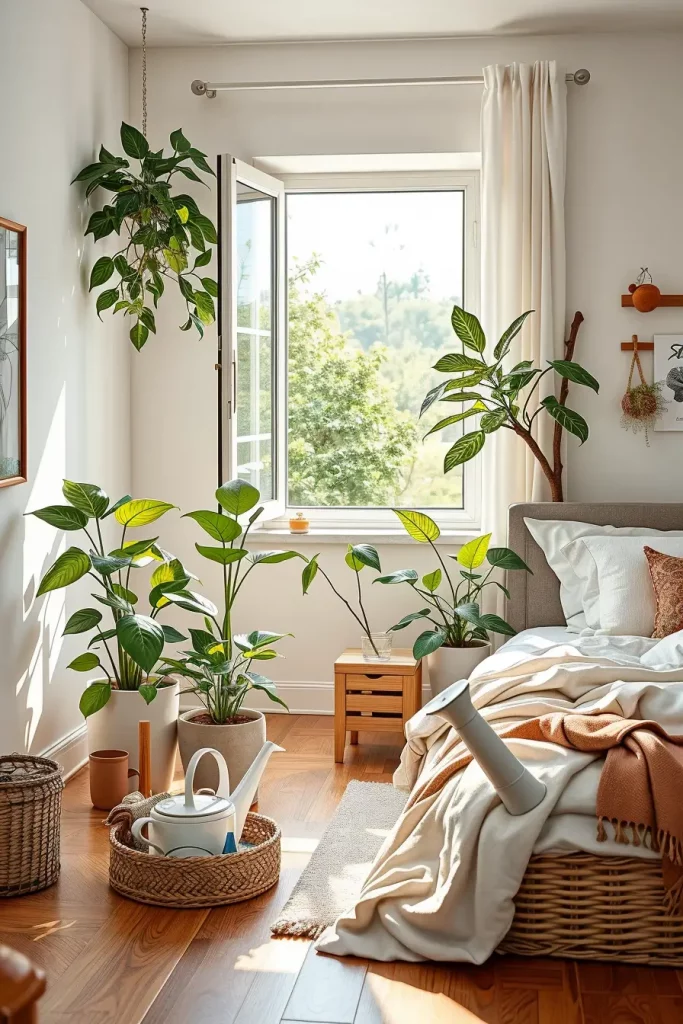
Choose self-watering planters if you want to grow monstera or philodendron. Choose bedding made from washable organic cotton or linen. Use oils that are not dangerous for you to treat your wood surfaces and keep them shiny. Having the room open for air, trimming houseplants, wiping dust off the items and shaking out natural rugs weekly keeps it both attractive and pleasant. This regular rhythm mimics nature’s own cycles and makes the bedroom feel alive.
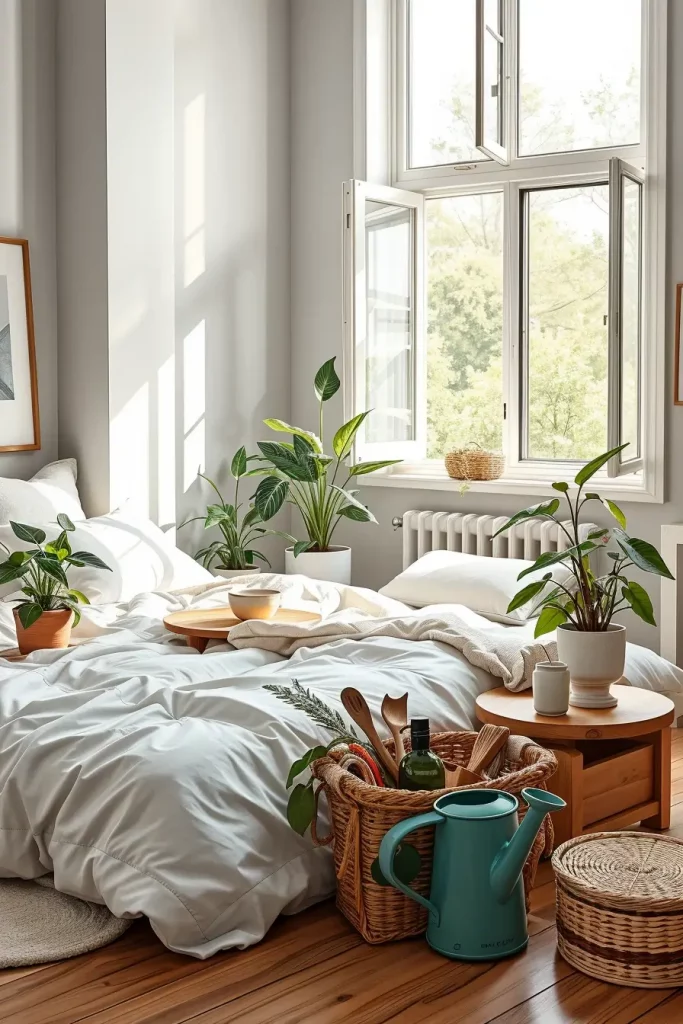
Snake plants, ZZ plants and pothos are always my top picks for those starting with indoor plants. According to Martha Stewart Living, by moving your plants around every few weeks to follow the light, you help them to grow. A watering can and a microfiber cloth close by can help you view cleaning your house as pampering yourself.
You might like to add a plant care calendar to one of your walls or a basket for storing cleaning supplies. It combines usefulness with pleasant design in accordance with biophilic principles.
Final Thoughts On Embracing Nature Indoors
Relying on Pinterest ideas alone won’t do if you want to truly enjoy your biophilic bedroom for long. Decorating with natural elements at home needs consideration, hard work and your unique touch. I think of it as a regular choice to create tranquility and energy within your home.

Something about your home should appeal to your senses which could be the soothing sound of wind chimes, a smell of woodsy cedar or a comfy handmade throw. The main thing is to be genuine. The room you sleep in should reflect your personality and respond to nature’s naturally changing environment. Using a nightstand carved from a tree trunk, artwork of forest trees above your head or paintings or prints with earthy blue and green can softly connect you to nature.
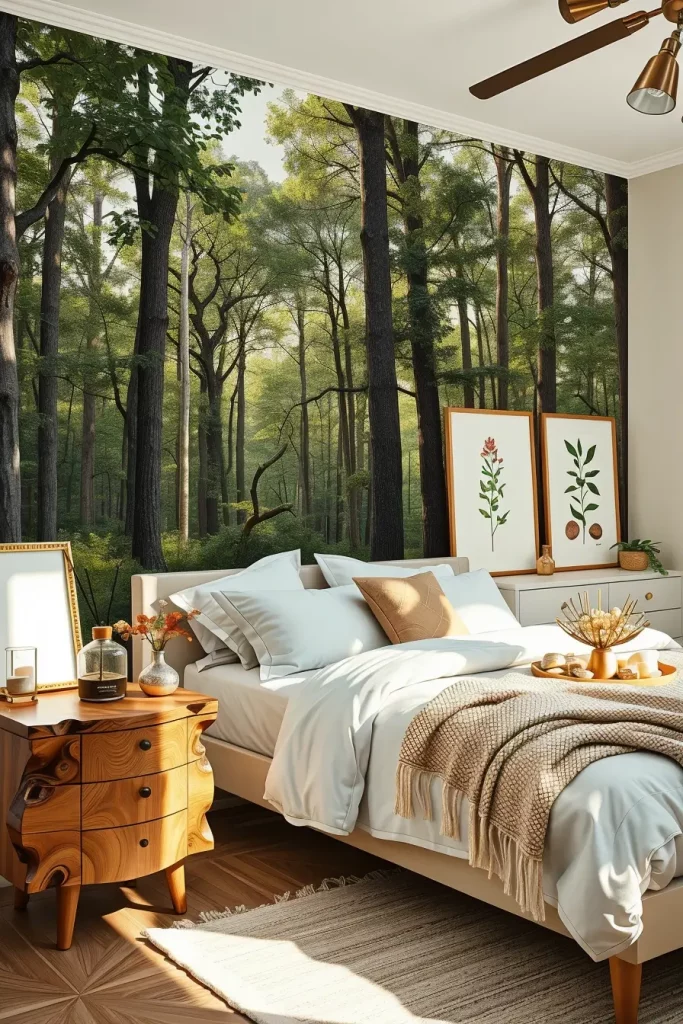
A few simple applications of biophilic ideas allowed some clients to both sleep better and feel happier. Elle Decor’s designers often remind us that nature is always stylish, so when you bring nature inside, you also bring its relaxing benefits.
Another idea to make this concept bigger is to add branches from trees that change with the seasons, perhaps some shells or other dried plants to look at their unusual shapes. Refreshing your furniture and decor to suit each season is as important as changing the outside world.
Bringing nature into your bedroom through biophilic design is more than a style choice—it’s a way to support your well-being every day. Whether you’re starting with a few plants or fully transforming your space, every step counts. I’d love to hear how you’re incorporating natural elements into your own bedroom—feel free to share your thoughts or tips in the comments below!
